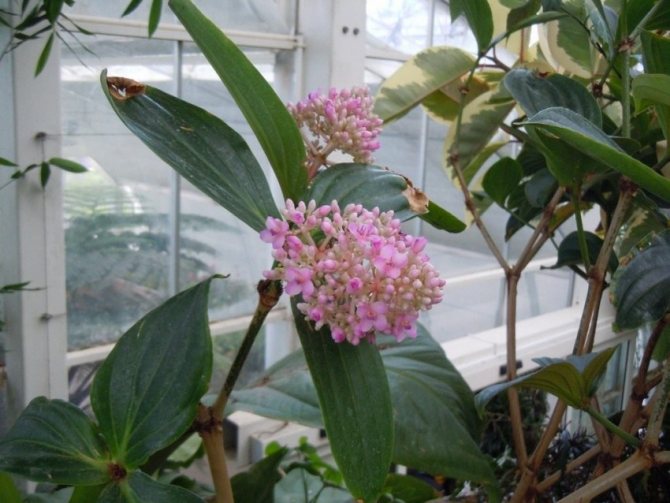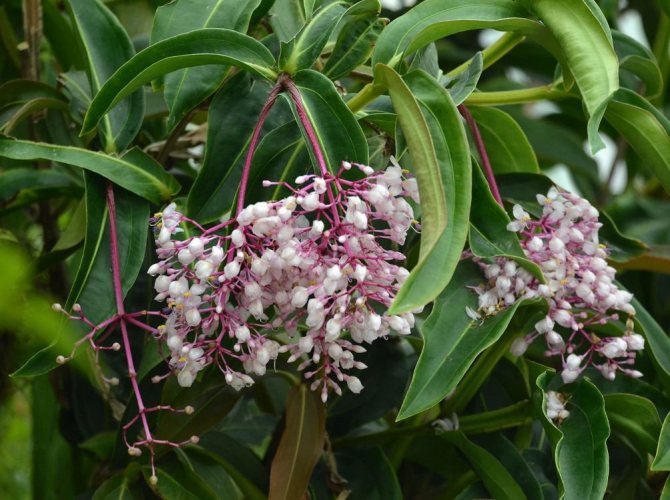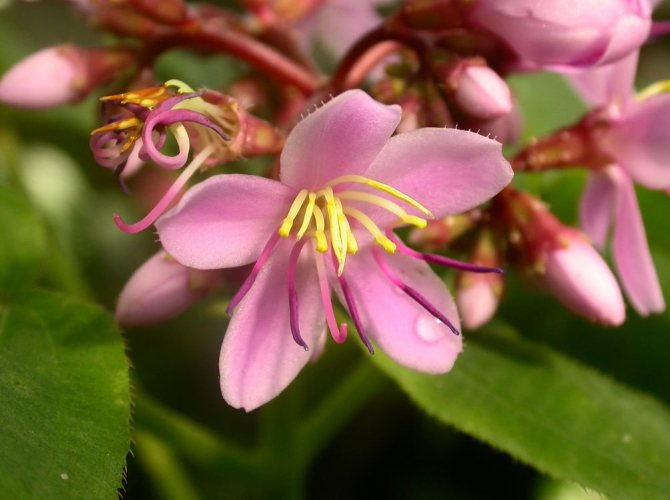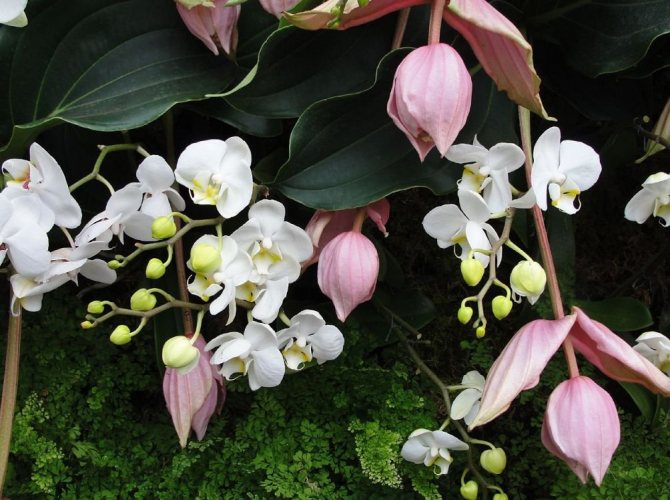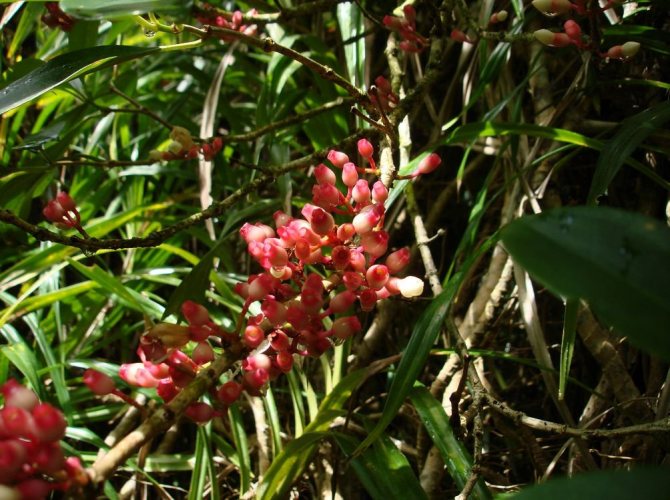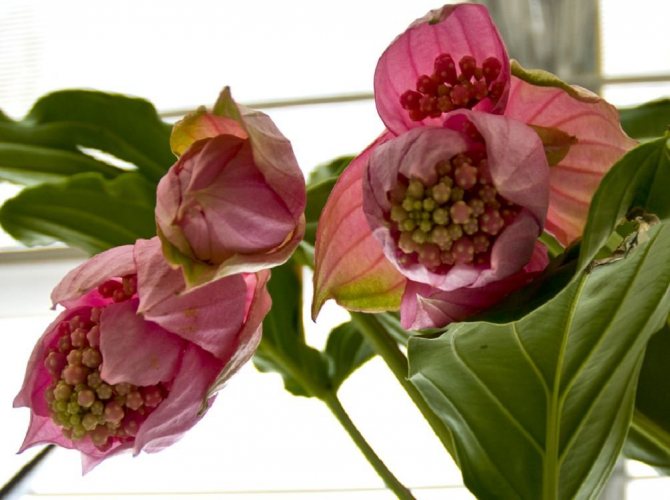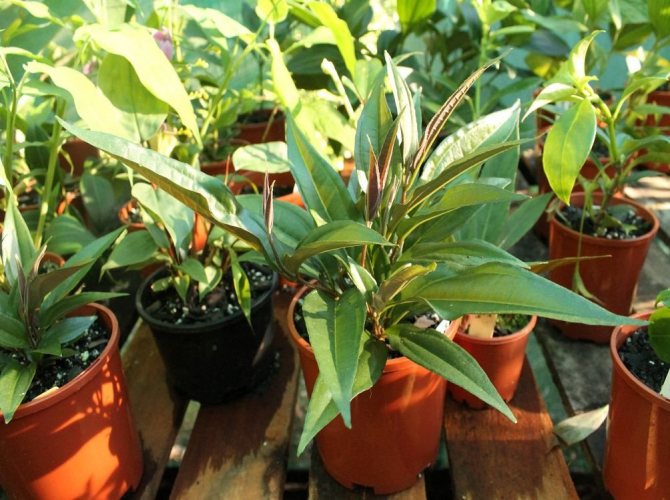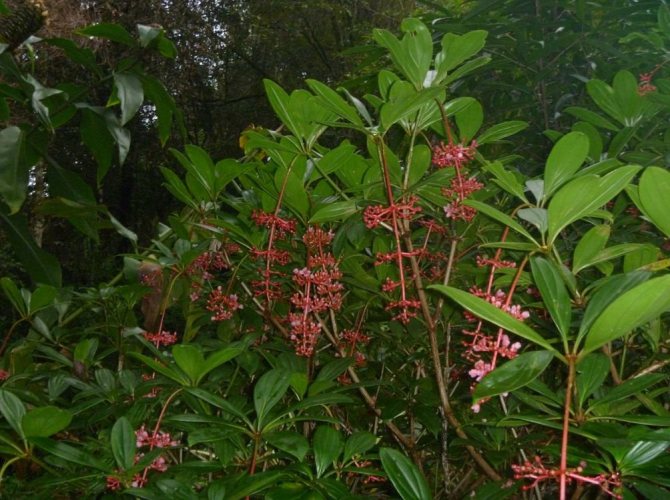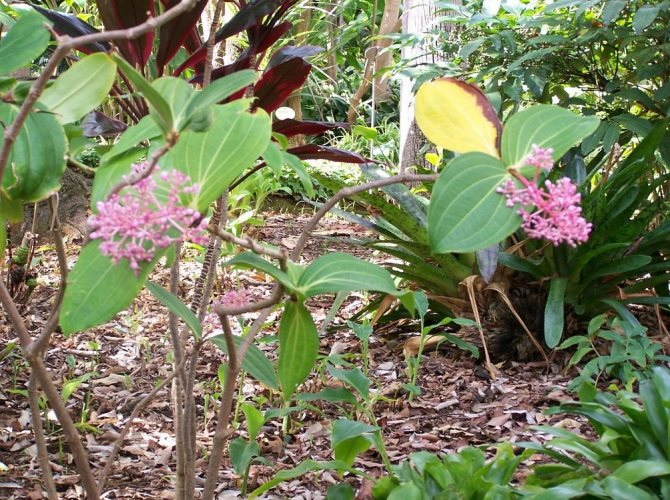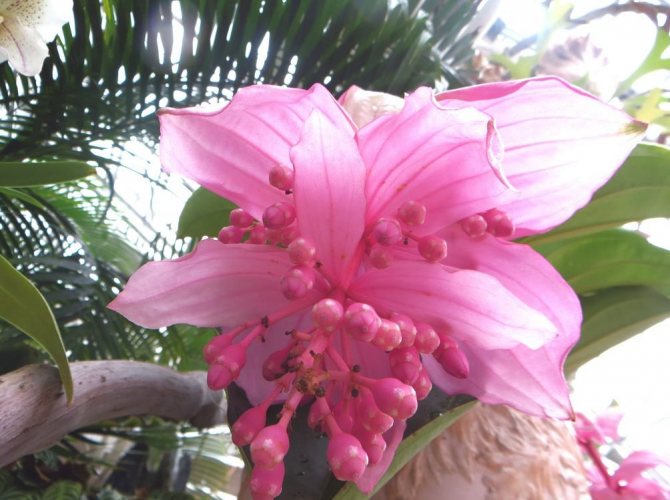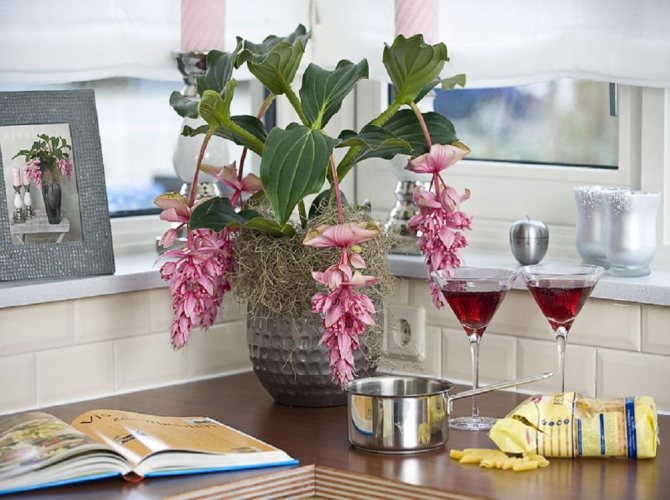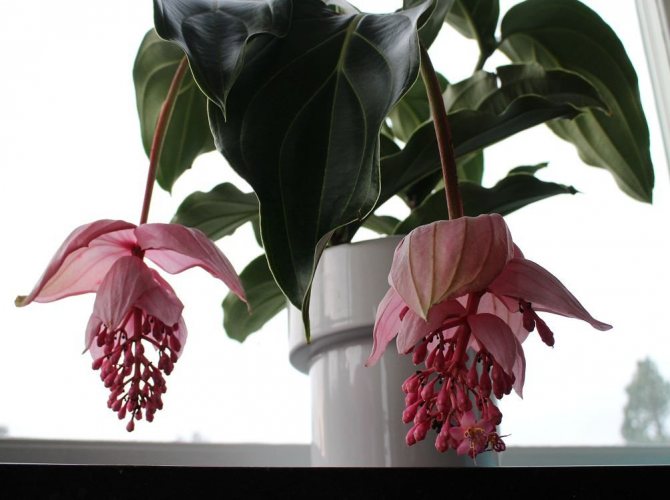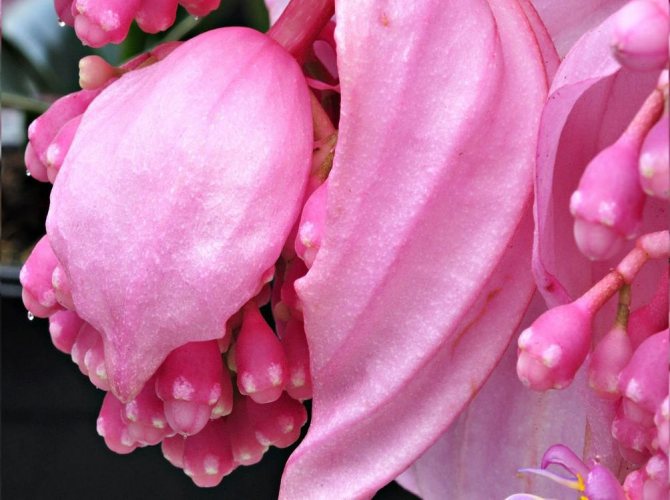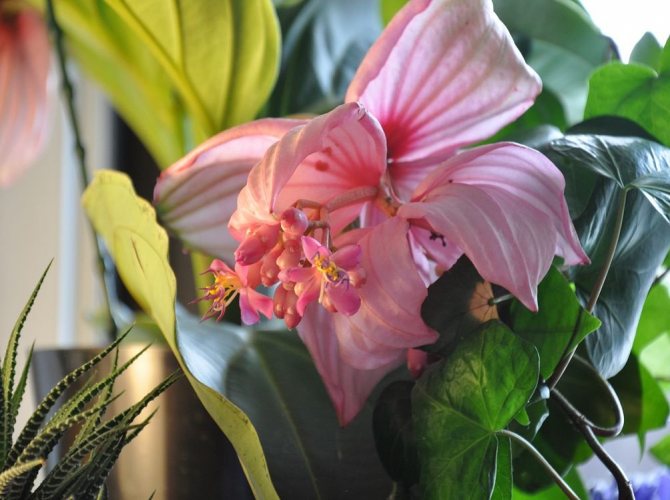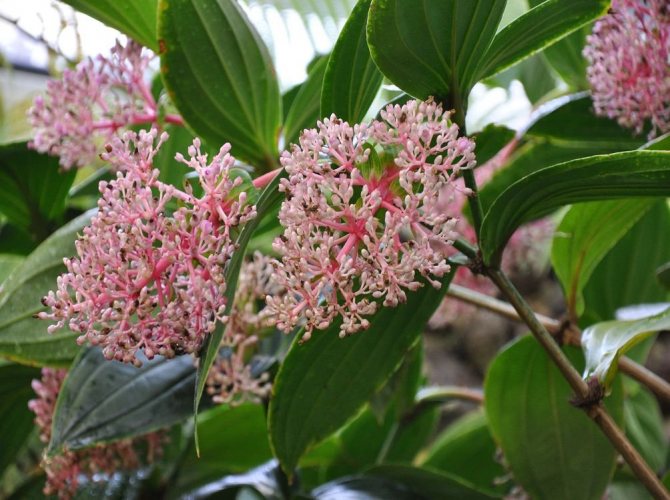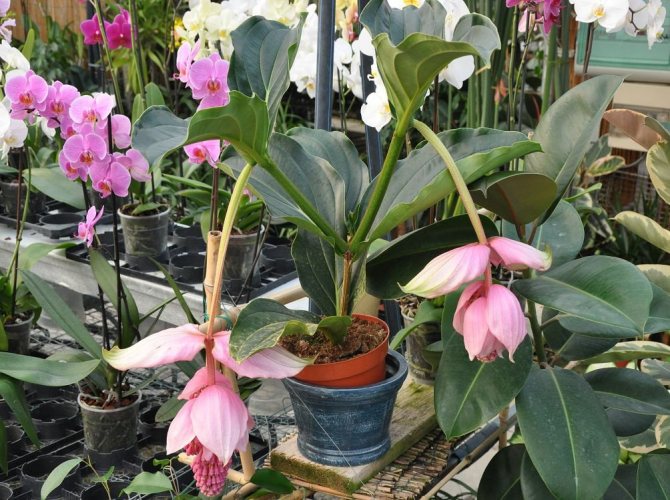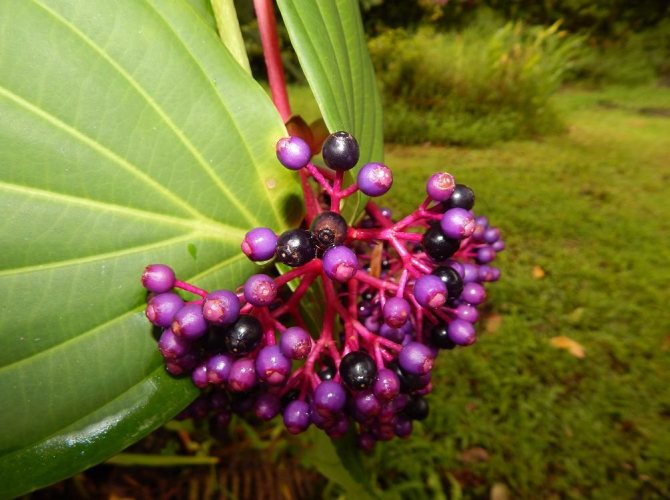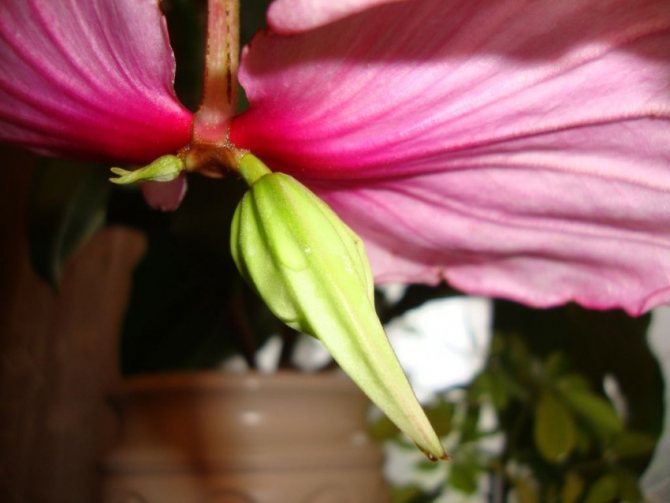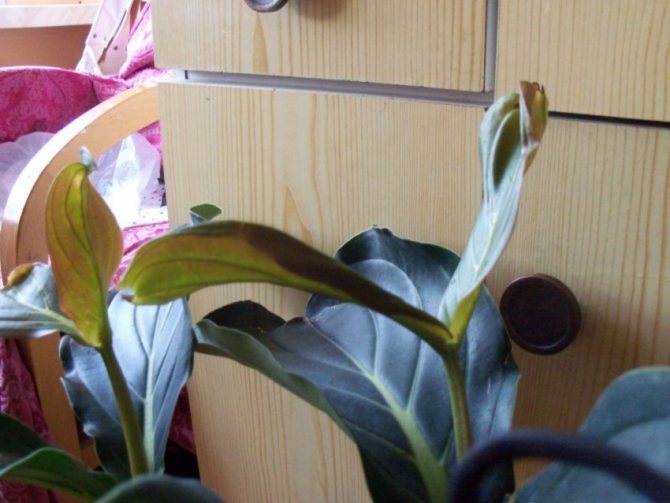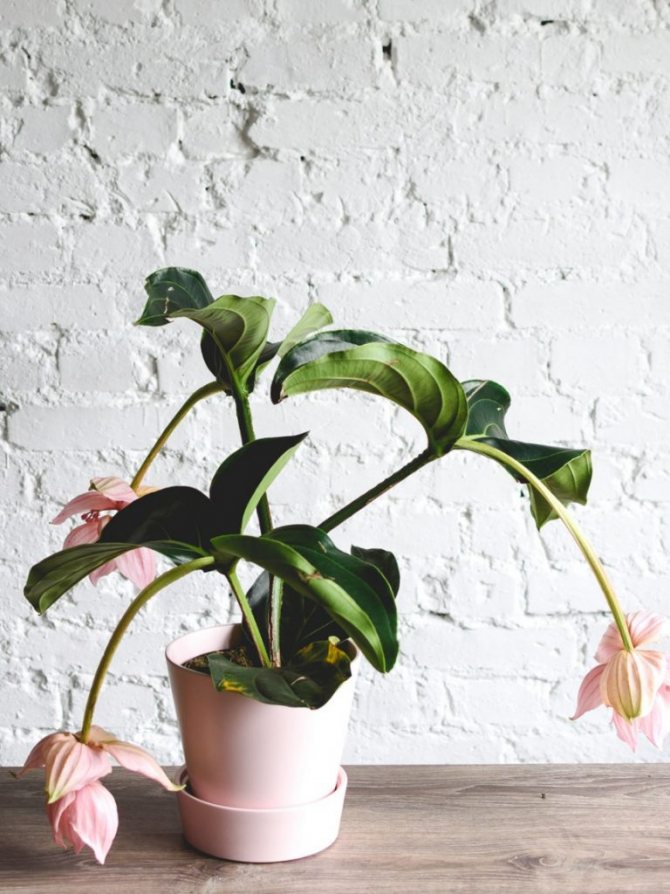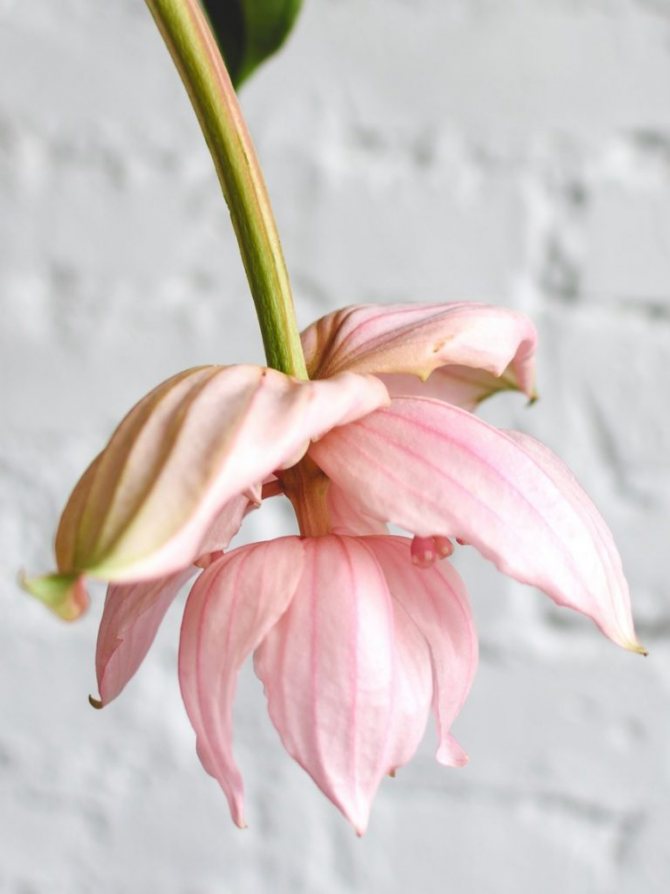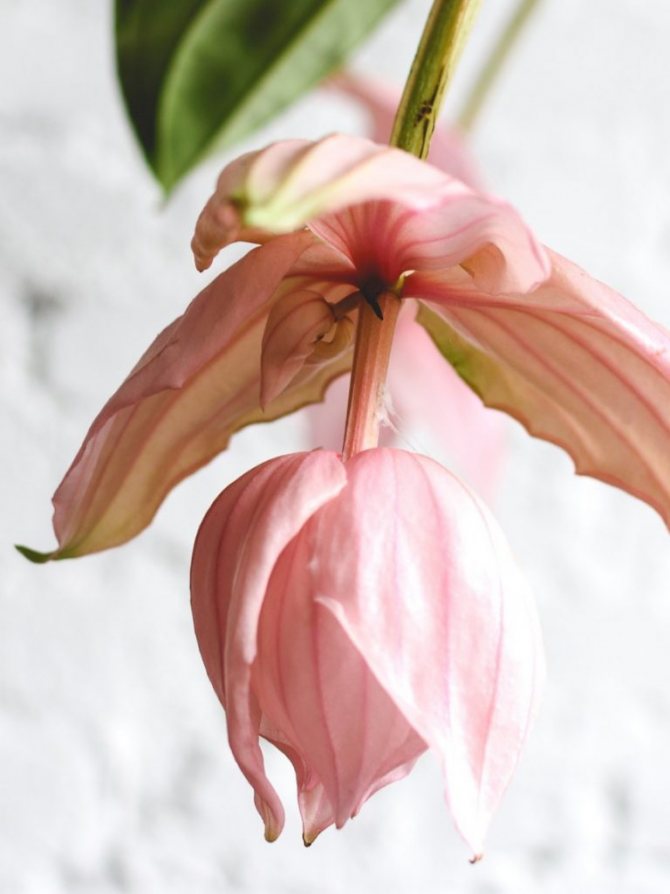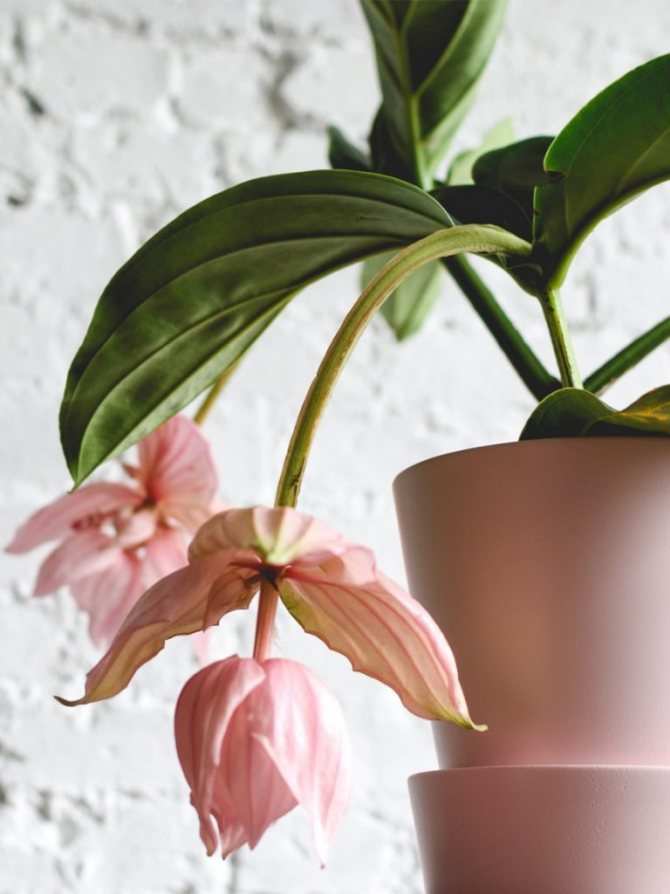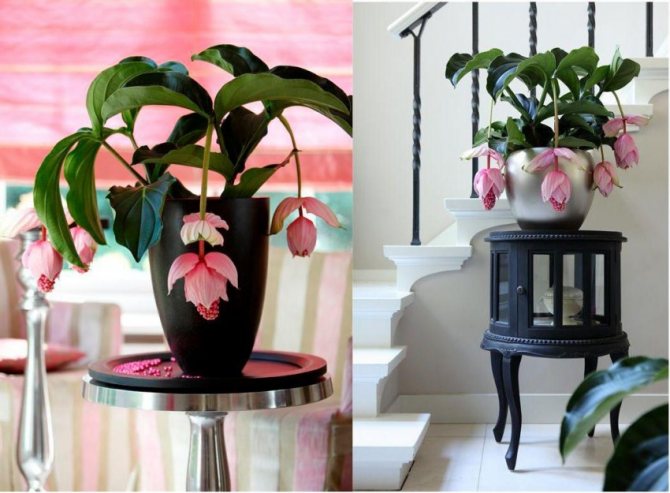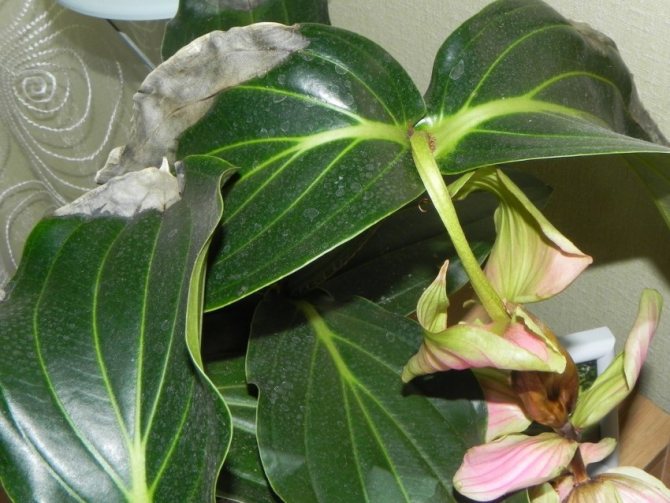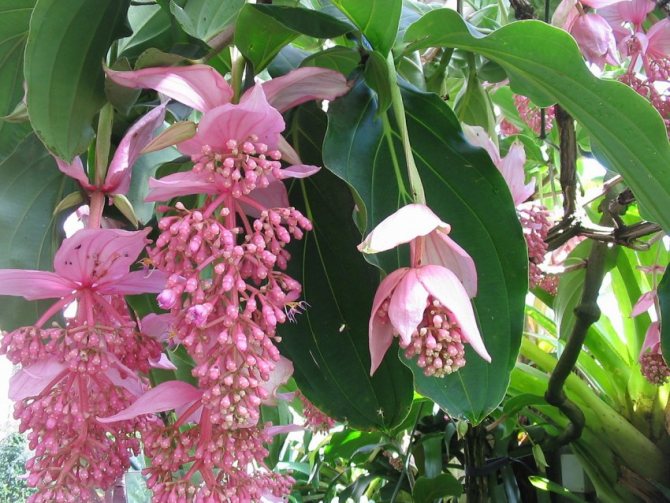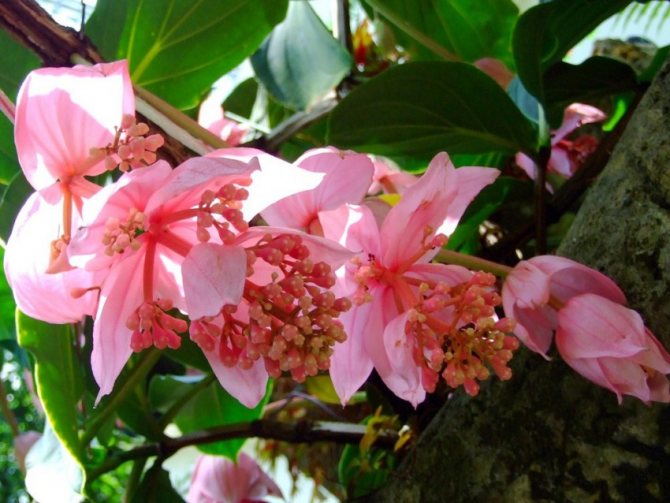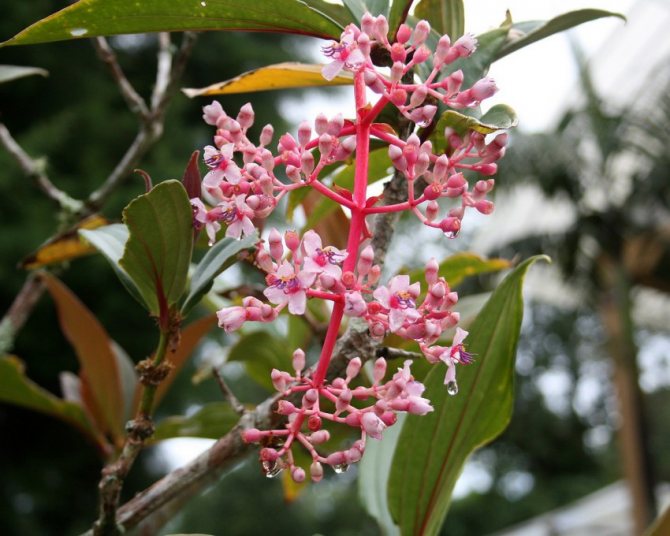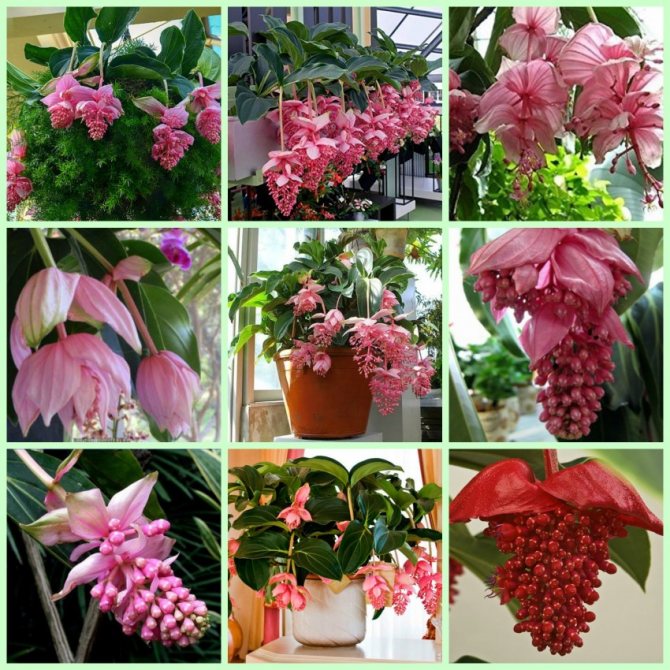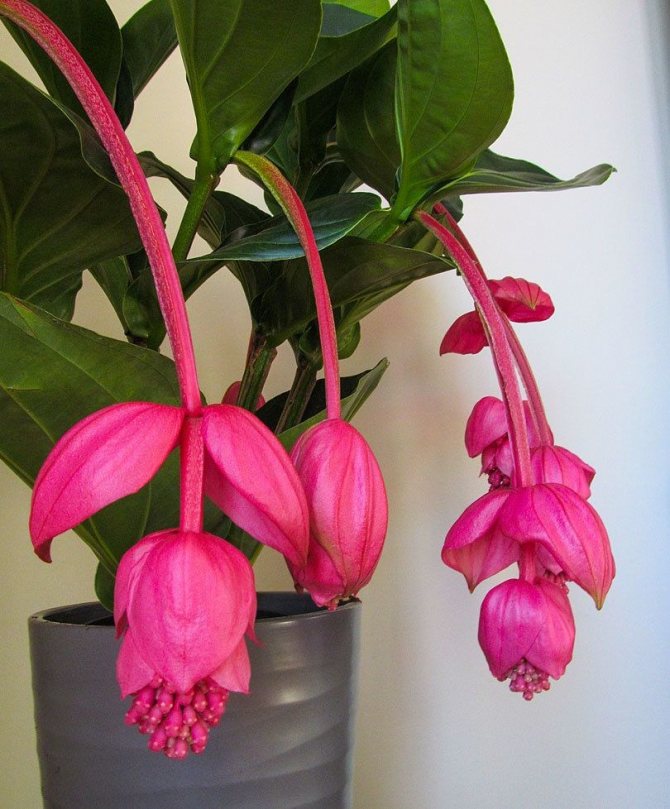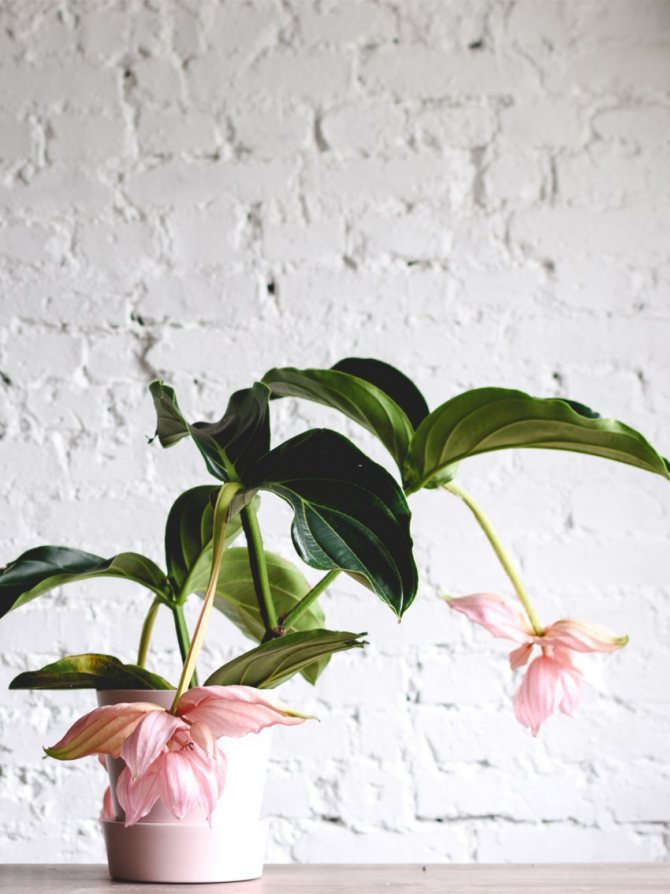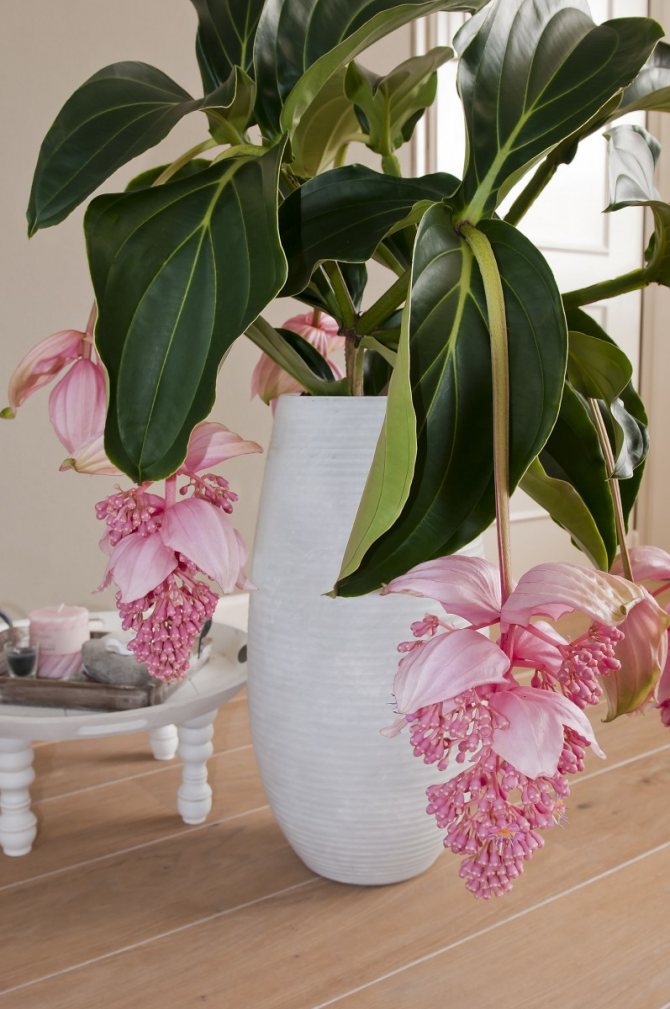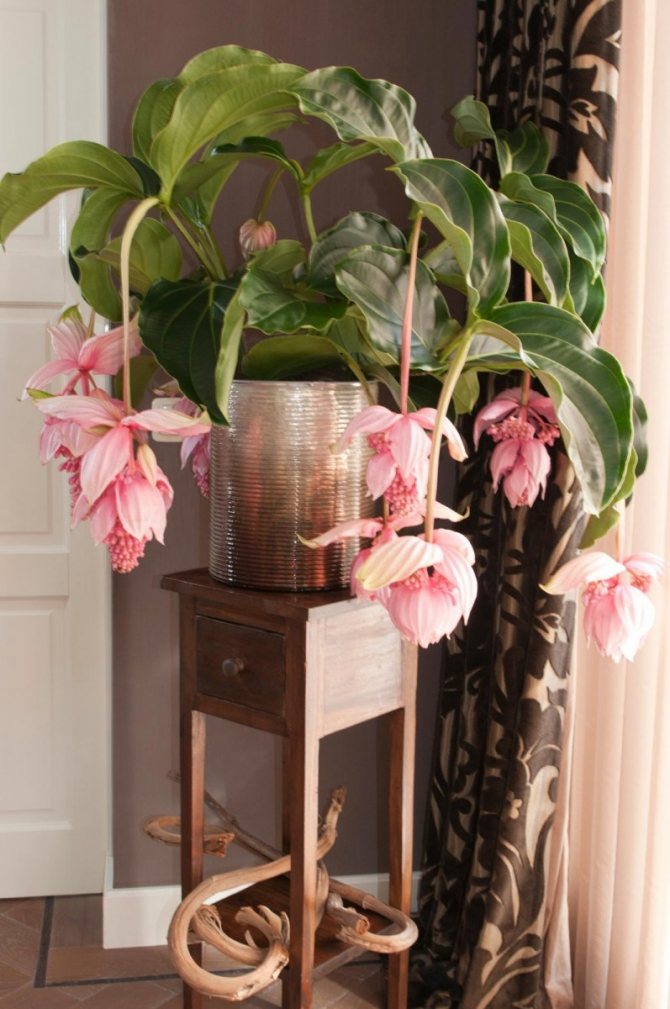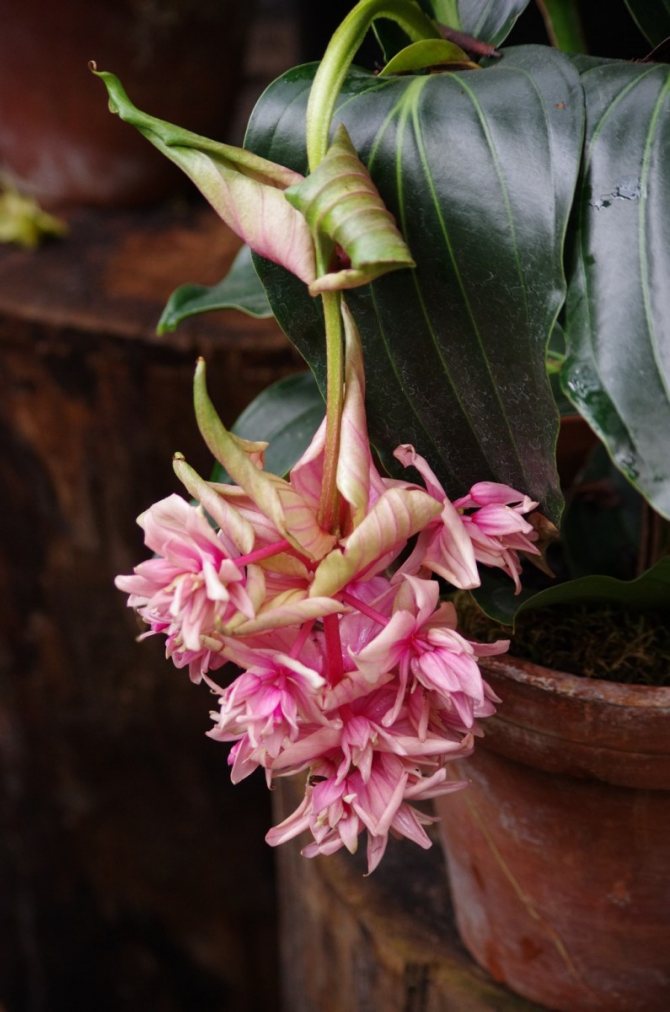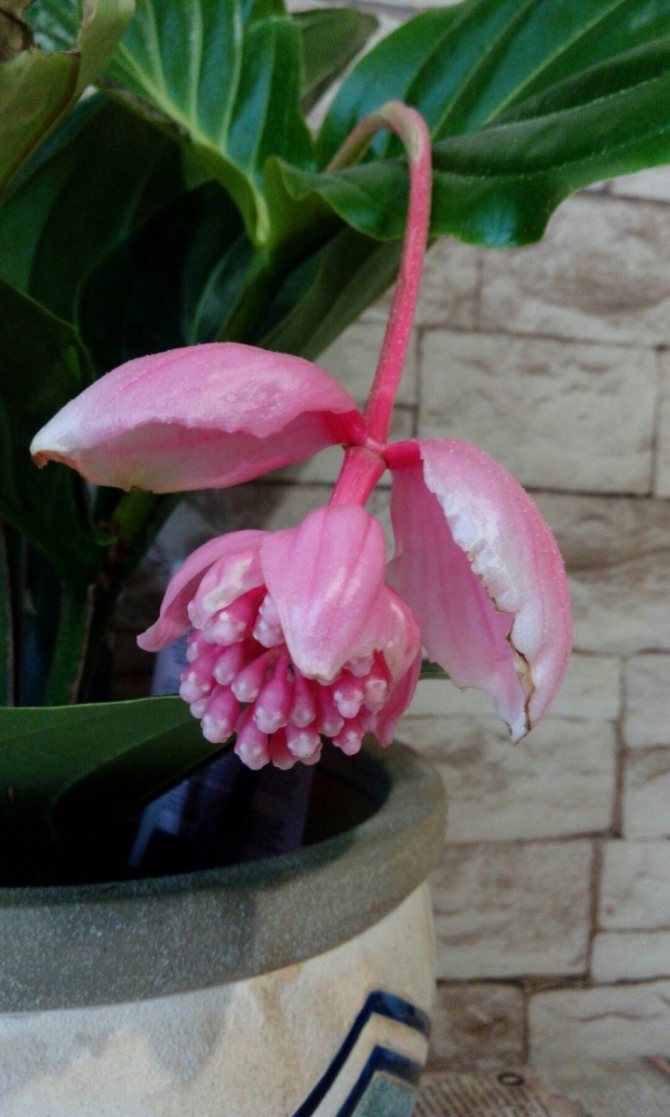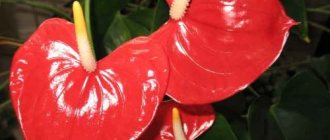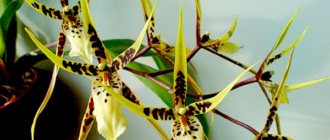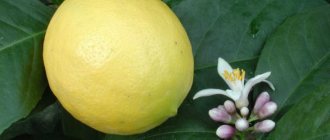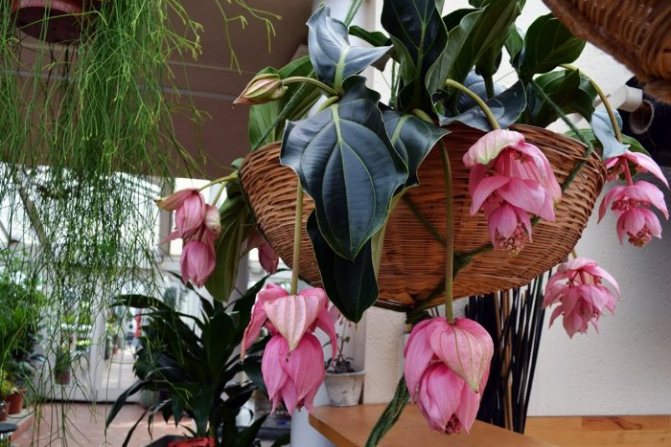
In this article, we will tell you how to properly care for a very difficult indoor flower of tropical origin - medinilla, which is very difficult to keep at home. Only a very patient, attentive owner, infinitely in love with flowers, will be able to adapt to the nature of this capricious beauty. And we will help you with this. She will not tolerate sudden changes in temperature, low humidity in the room, rearrangement of the pot from place to place, open windows in winter or the sun that burns her leaves in summer. Most of this is not tolerated by many tropical plants, but we will consider, in order, the rules for caring for at home just for medinilla.
Location and lighting of the flower
It is known that medinilla feels equally bad both with a lack of sunlight and with prolonged exposure to sunlight. But the oblique rays of the sun in the mornings and evenings are simply necessary for the plant. Based on this, you will find a suitable place for a flower on the south side of the apartment a little in the back of the room. If you place it on or near a windowsill, then at noon be sure to shade the plant with light curtains or blinds. Otherwise, irradiated with ultraviolet rays, the plant will get sick or even die.
Windows of eastern and western directions are also suitable for medinilla, but in the autumn-winter periods, illumination with artificial lighting or phytolamp will be required. The plant needs at least 12 hours of daylight. It should be remembered that the distance from the lamp to the crown should not be closer than 60 cm, otherwise you will burn the delicate leaves and inflorescences. Northern windows for a flower will not work, because even in the summer there it will not have enough sunlight.
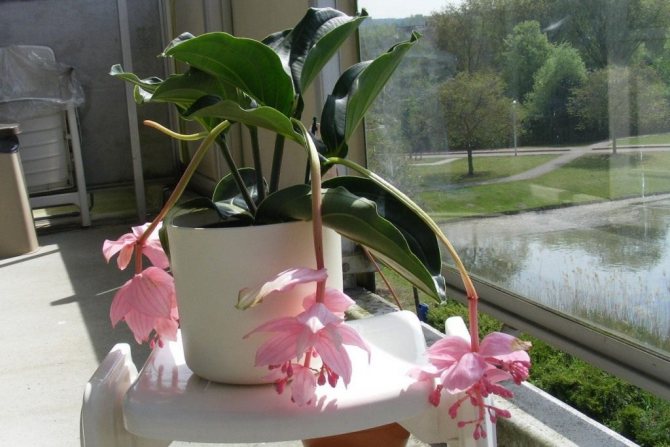

The pot with medinilla should always be in the place you choose. It is not advisable to rearrange it, and during flowering it is simply unacceptable. Consider when choosing his place of residence and the fact that the plant does not tolerate drafts and hot air near heating devices in winter.
Florarium
Some growers grow medinilla in florariums. A florarium is a composition of living plants grown in a glass terrarium. This can be an aquarium, glass, jar. In addition to plants, there can be various decorative elements: beautiful pebbles, parts of driftwood, shells. In such a home greenhouse, medinilla will feel great, provided it is a compact variety or is still very young. For example, a dwarf species - medinilla sedum-leaved, grows well in the florarium, where a mild microclimate with high humidity is created for it.
You can read about medinilla sedum, as well as many other types and varieties of medinilla. here.
For tall and spreading specimens, a home florarium is not suitable. You will need a large transparent aviary (showcase or window) with special equipment for irrigation, lighting, ventilation and bottom heating. Such a structure is not cheap, therefore it is a rarity.
Conditions of detention
For room medinilla, it is necessary to create conditions close to the natural habitat.
Comfortable growing conditions - table
| Lighting | Medinilla prefers to grow in a bright place, but not in bright open sun.Even light partial shade can adversely affect flowering. Reacts well to additional artificial lighting, especially in winter. The distance from the lamps to the plant should be at least 60 cm, so the leaves will not be burned. The best place is a window of the east or west direction; on the south side it is necessary to protect from sunlight. |
| Temperature regime | The optimum air temperature during development is + 20 ° С. During the dormant period, the room should not be lower than + 16 ° C - the cold is destructive for the flower. The fragile beauty should be protected from drafts. |
| Humidity | The plant feels good in a humid microclimate - the air humidity is more than 70%. Dry air can lead to yellowing of the leaves and even the death of the flower. Therefore, it is necessary to often spray medinilla, you can put a pot with it on a pallet with damp decorative stones. During the heating season, the flower should not be kept near the radiator. |
| Watering | In the spring and summer, regular watering is needed once a week. However, it is impossible to overmoisten the soil - this can cause rotting of the roots. In winter they water less often. |
| Fertilizer | In spring and summer, every 2 weeks they are fed with mineral fertilizers. In winter, feeding is not carried out. |
| Transfer | Young plants are transplanted annually, adults - every 3 years. |
| Pruning | After flowering, the medinilla is cut off and some of the overgrown shoots are removed. |
| Reproduction | Propagated by seeds, cuttings. |
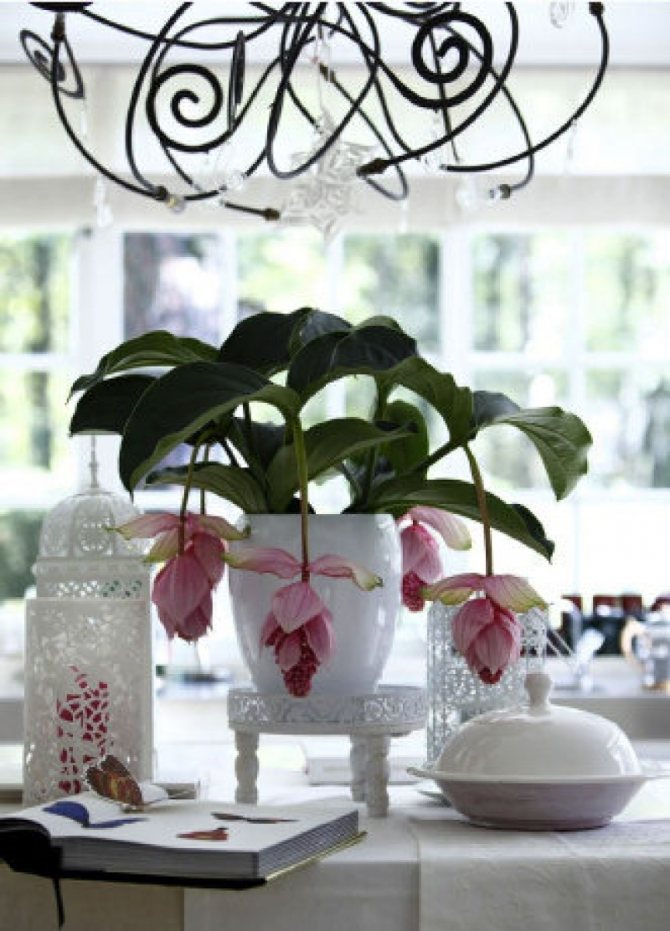

For room medinilla, it is necessary to create comfortable conditions
The plant feels comfortable in a greenhouse and an open-type florarium. Especially dwarf species - medinilla sedumous with creeping shoots and bright pink flowers grows well in the terrarium, where a comfortable and mild microclimate with high humidity is created.
On a note. A florarium is a composition of fresh flowers grown in a glass terrarium - a jar, a glass, an aquarium. A “garden in a bottle” made up of plants and decorative elements (driftwood, pebbles) will decorate any interior.
Medinilla needs space, she does not like close proximity with other flowers.
Humidity
The plant will feel comfortable only in a room with high ambient humidity, i.e. at 70-80% throughout the year. To achieve this, spray the leaves daily with room temperature water. During flowering, try not to hit the buds and opened medinilla flowers with a stream. Place a wide container of water near the pot to evaporate it. If you have a household humidifier, turn it on if you suspect that the humidity level drops below 70%. This is especially true for the winter period, when heating devices work in the house, which significantly reduce the level of humidity in the premises.
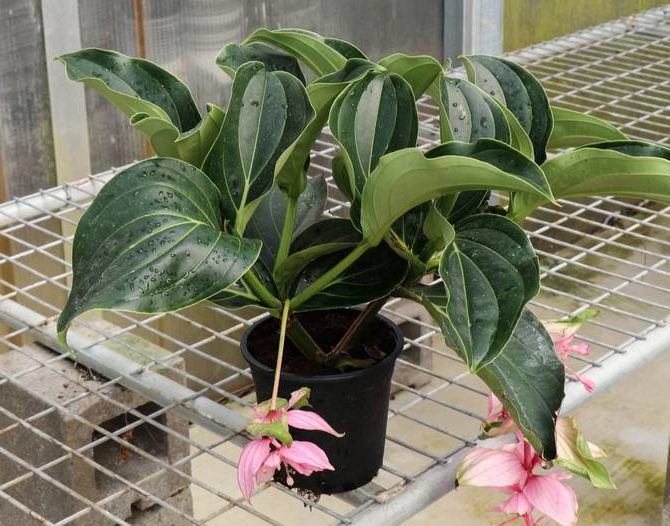

From dry air, the foliage of the plant becomes smaller, medinilla loses its attractiveness and resistance to diseases and pests. Therefore, as soon as the flower begins to lose its decorative effect, urgently increase the humidity of the air, at least near the pot. Cover hot batteries with damp towels. Place the pot in a tray with wet expanded clay. Just make sure that the roots of the flower do not touch the water.
When creating high humidity in a warm room, there is a high probability of fungal diseases. To prevent them, regularly ventilate the room, while not forgetting that the flower should not fall under a stream of cold air.
The plant loves a warm shower for the stems and leaves, but it is important to avoid getting moisture on the flowers. The soil in the pot should also be covered with plastic to prevent it from being washed out of the pot.
Cleanliness is the key to health
We draw your attention to the fact that the purity of the surface of its leaves is important for the health of medinilla. If the leaves are covered with a thick layer of dust, the flower can get sick. After all, a layer of dust closes the pores on the leaves, complicates air exchange with the environment.In addition, the dust layer impairs the process of photosynthesis, and if it is not removed, medinilla will begin to suffer from nutritional deficiencies. Moreover, dust can cover harmful substances and be a refuge for harmful insects.
Therefore, it is necessary to regularly (once a week) wipe the leaves with a damp soft cloth or sponge. To make it easier, first spray the flower with warm water. Carry out this event in the morning, so that by the evening the plant will dry out.
Sometimes, for greater beauty, the leaves are given a gloss with the help of folk remedies. For polishing, use beer, milk or a weak solution of vinegar. But this gloss can only be applied to mature plants. Young bushes should not be touched.
Home care
The flower is rather capricious, demanding on the conditions of detention, does not tolerate being rearranged from place to place, even turning the pot.
Watering
Medinilla needs to create a comfortable, humid environment. Therefore, you should spray the plant more often, wipe the leaves with a damp cloth. At the same time, make sure that no water gets on the substrate or buds.
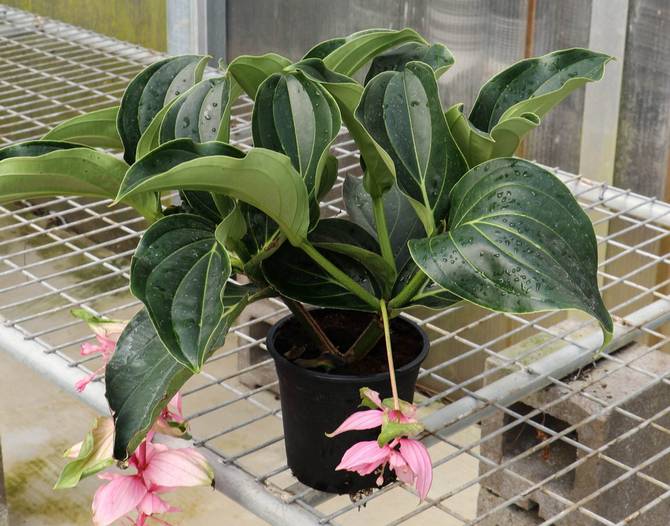

Medinill should be sprayed with water more often, have a shower
In the spring and summer, watered once a week. During the dormant period, watering is reduced, allowing the soil to dry out to a depth of 3 cm. This mode of light moistening is observed until the buds appear. Then the volume and frequency of watering are sharply increased, but without leading to waterlogging. A significant saturation of the substrate with moisture and a simultaneous increase in the temperature regime will give the plant an impetus to a more lush flowering.
Medinilla is watered only with soft water. The presence of a large amount of salt in the water can lead to diseases.
Recent Entries
Rose Petal Jam and Its 7 Health Benefits You Likely Didn't Know About What Fruit Are You According to the Zodiac Sign The 11 Best Grape Varieties That Will Help You Create Unique Homemade Wine
Top dressing
Fertilizers are very important for the plant - they ensure its growth and abundant flowering, as well as resistance to diseases. From March to August, they are regularly fed every 2 weeks with liquid fertilizer for rhododendrons or flowering plants. No feeding is carried out from August to February.
For top dressing, complex fertilizers for indoor flowers are used.
To maintain immunity, it is useful to carry out a cycle of spraying the bush with Epin's solution.
Watering
This moisture-loving plant should be regularly watered with soft, settled water at room temperature. Even a slight drying out of the soil will lead to drying of the tips of the leaves and shedding of flowers. During the formation of buds, the soil must be constantly moist. But do not allow swamps, excess water from the pot should flow freely into the pan, from where it should be removed in a timely manner. During flowering, the intensity of watering is slightly reduced, and during dormancy it is completely reduced to a minimum and watered only after the soil in the pot dries out by half. The rule applies here - the lower the temperature, the less watering.
It may be interesting: Indoor Cineraria - planting and care at home
Description of the flower and photo
The homeland of medinilla is the humid evergreen tropical forests of the Philippines, which, with a bizarre variety of plant forms and a riot of colors, resemble fabulous gardens.
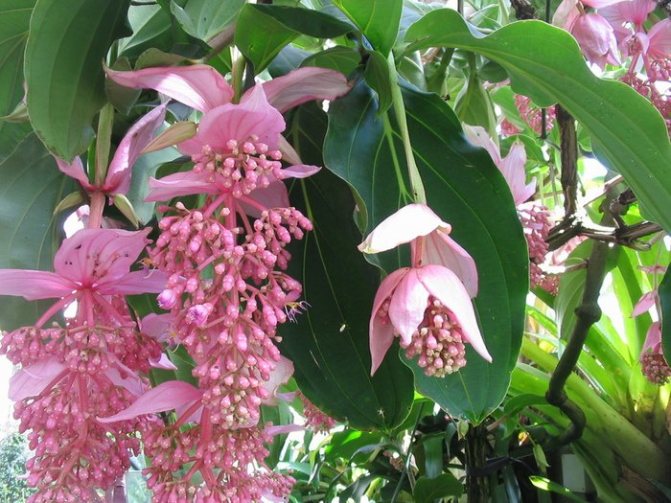

Homeland of medinilla - humid evergreen tropics
The genus includes more than 300 species of shrubs and lianas. Plants can grow up to 2 m in height. Their stems are covered with thickened leaves up to 30 cm in length, glossy, oval, grayish-green, with clearly visible light veins. But medinilla is still valued for its exotic flowering.
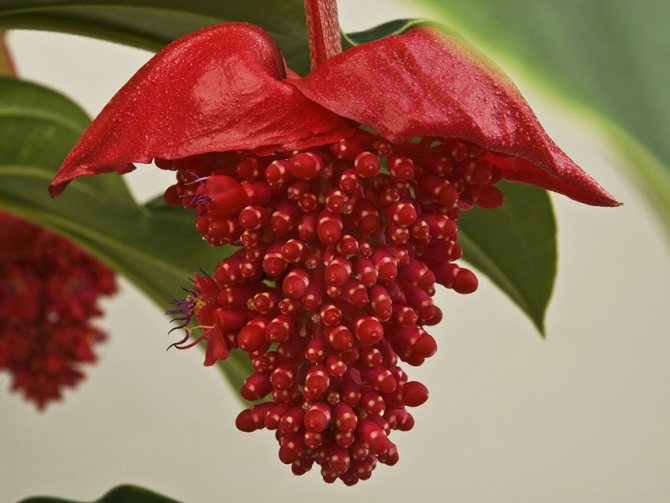

The plant is prized for its exotic flowering
She received the specific name "magnificent" due to the delicate bright pink drooping inflorescences in combination with large bracts.
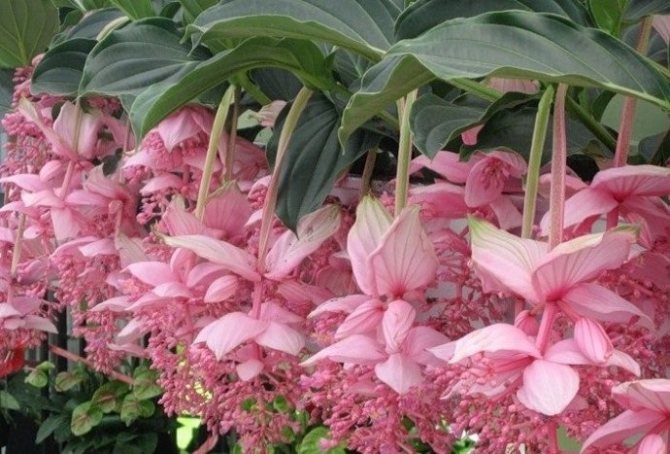

Medinilla gorgeous got its name from delicate bright pink inflorescences
This fragile beauty is not easy to grow at home. For her, not only temperature and lighting are important, but also the location, compliance with all the rules of maintenance. However, knowing and taking into account all the subtleties of cultivation, you can achieve lush flowering.
The soil
Under natural conditions, medinilla is an epiphyte, that is, it often grows on the trunks and stems of other trees or shrubs. She is content with the meager land, consisting of the remains of other plants and insects. It gets food and moisture from the ambient air and organic residues on the stem. When growing it at home, in a pot, you must take care of the nutritional value of the soil, its looseness, weak acidity, air and moisture permeability. If you find special soil for epiphytic plants, rhododendrons or orchids in the store, it will be great. Otherwise, you will have to prepare the potting mix yourself, in approximately the following proportions:
- leaf and sod land for 2 hours,
- peat, humus and sand - 1 hour each.
To increase air permeability, we recommend adding a small amount of coconut substrate or chopped wood (pine) bark here. This soil composition will ensure that after watering the soil will dry out in a maximum of two days. If you collect land on the garden plot, then the soil after watering will dry for a week or longer. It will surely turn sour, and the root system will rot.
Types of medinilla
So, as mentioned above, there is a magnificent medinilla - or, in other words, a magnifica medinilla. This particular variety is most often sold in stores and grown at home. It is a shrub up to one and a half meters and lives exclusively in the Philippines and the island of Java. It was this variety that was introduced to Europe.
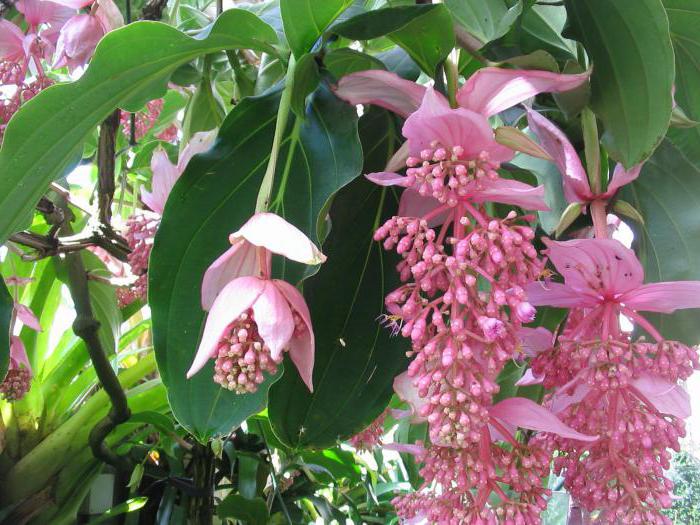

Leaves of medinilla magnifica are 35 centimeters long and 15 centimeters wide, white-pink flowers of a wide variety of shades are similar to bells. It has a subtle scent that changes strength throughout the day. Due to its place of residence, it is a rather capricious plant, it loves warmth and moisture, therefore, it is not uncommon to take care of the medinilla at home. Good for greenhouses and greenhouses, as well as botanical gardens. As a rule, it is difficult to grow it in a private apartment. Blooms in late spring. In nature, it is an epiphyte (that is, how the liana lives on other plants).
Another type of medinilla is Cuming. It also grows only in the Philippines. It is half epiphyte. The shrub is small, but very spreading. The leaves are smaller than those of medinilla magnifica, but they are also large - up to 20 centimeters wide and 30 centimeters long, oval. Pink flowers appear from March to May.
Medinilla veinous is distinguished by elongated pointed leaves up to 20 centimeters long and snow-white, yellowish-pink or beige flowers. Lives in Malaysia. This species is also a semi-epiphyte. It is quite rare.
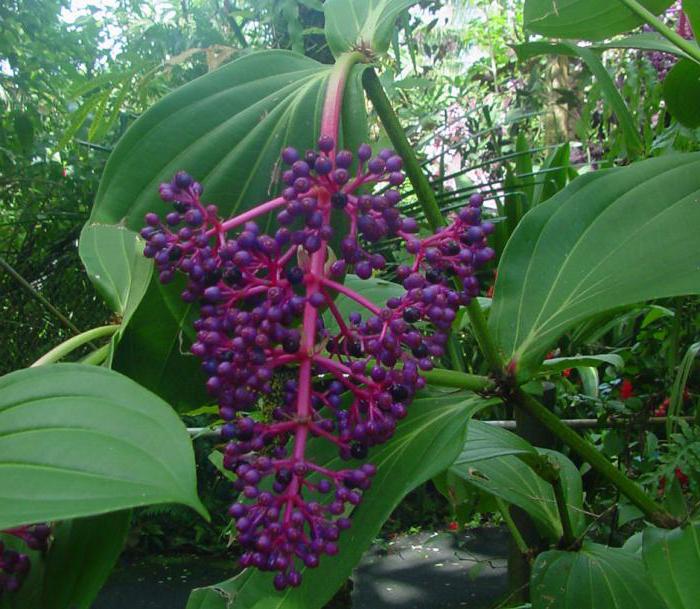

Medinilla is a bright purple hue. This is the least capricious variety of all listed, which easily gets used to the humidity and temperature of the room. The shrub is small in size, the leaves are oval.
In total, botanists know about four hundred types of medinilla. However, only these four are decorative, found in stores and are in demand among gardeners.
Pot
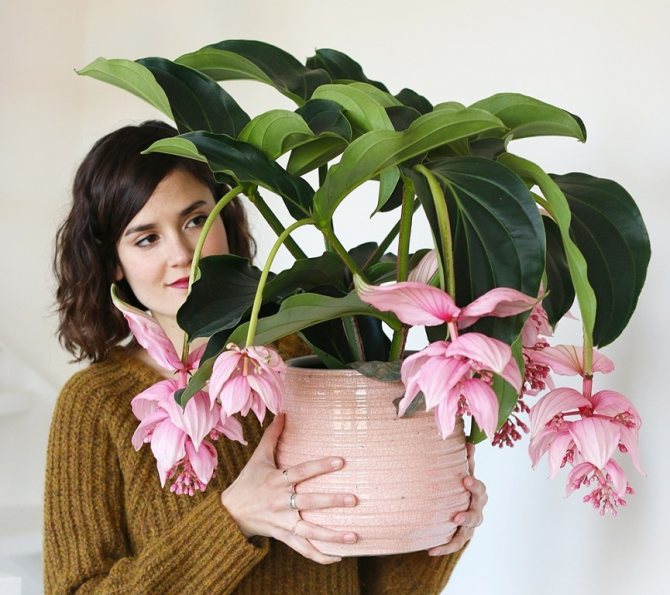

A small but wide pot is required, since the medinilla root system, like all epiphytic ones, is located at the surface and is not very developed. It consists of adventitious fibrous roots that grow in breadth, and not in depth, and does not require a large volume of earthen mixture.To let the flower brushes hang freely, place the pot in a tall planter or on a stand. If you have a deep pot, then take up a third of it with drainage material. Any pots will do - both plastic and ceramic. We recommend buying plastic pots for hanging baskets as they are lighter. But it is better to put a heavier and more beautiful ceramic pot on a flower stand so that it does not tip over and looks more organic.
There should be drainage holes at the bottom of the pot to drain excess water. Together with a good drainage layer, this is a guarantee that moisture will not stagnate in the pot, and the root system of the flower will not suffer from decay. Expanded clay, broken red brick, large vermiculite, crushed foam or perlite can be used as drainage.
Exotic princess
The uniqueness of medinilla begins with its name. The flower, whose homeland is the Philippines, received its name in honor of the governor of one of the islands in the Pacific Ocean, Jose de Medinilla and Pineda. The plant lives in tropical forests, where it is always warm and humid. Interestingly, the Europeans did not immediately recognize its true habitat. A certain British naturalist, while on a research trip to the Philippines in 1850, came across an evergreen exotic beauty and, of course, brought it home. But for some reason he announced that he had brought it from Indonesia. The truth was revealed much later. It turned out that over two hundred different species of this plant live in the jungle of the Philippines! Medinilla is now under threat as rainforests in the Philippines are actively being deforested.
Transfer
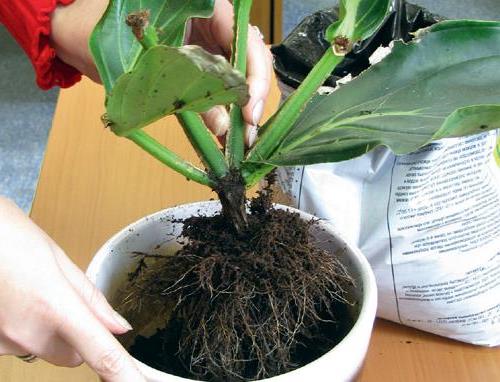

We recommend replanting an adult Medinilla plant no more than once every three years, after flowering and pruning. And even then, if there is an urgent need. Medinilla has a very sensitive root system, it is better not to disturb it again. Every year you can change the topsoil with a layer of 5-7 cm on fresh soil without changing the pot. But young, actively growing bushes, if necessary, can be transplanted every year. It is best to carry out this procedure in early spring, when the plant has not yet begun to form buds.
Before planting in a new pot, try to clean the root system of the flower from the old soil, remove all dry and damaged parts of the roots. Pour new soil into the pot on top of the drainage layer. Place the flower in the center and cover any voids around the plant's root system with substrate. Do not tamp. Water. Top up with soil if necessary.
The first time after transplantation, we recommend supporting Medinilla with special preparations to improve root formation. To do this, add Kornevin or Zircon to the water for irrigation once a week according to the instructions. You can also spray the leaves with a fine spray bottle with Epin's solution (2-3 drops per glass of warm water).
If the plant is too large, do not transplant it. They are limited to replacing the topsoil by 5 cm.
Planting and transplanting a houseplant
Medinilla develops well and blooms in a slightly acidic substrate. The soil should be light, breathable and nutritious, consisting of peat, humus and sand. They also use ready-made soil mixtures for rhododendrons, azaleas.
Since the flowers of the tropical beauty gracefully droop, the pots for her are selected high. To avoid stagnation of water, expanded clay, crushed polystyrene with a layer of 3 cm, is placed on the bottom of the container.


Only tall pots are suitable for a tropical beauty
Young plants are reloaded annually, adults - once every 2-3 years. They are transplanted after flowering and pruning are completed, taking care not to damage the rhizome. The transplant is carried out only when there is a need for it.Medinilla has a very sensitive root system, which should not be disturbed once again. You can simply replace the topsoil (5–7 cm) regularly with fresh soil without changing the pot.
When buying in a store, pay attention to the stem - it should be green and without spots, the foliage should not show signs of yellowing. A healthy plant must be transplanted into a new soil, giving it several hours to adapt to new conditions. The leaves are pre-washed with warm water, washing off the preparations with which the plants are treated before sale. The earthen lump should dry thoroughly.
When transplanting, pay attention to the root system
- The pot is selected 5 cm larger than the previous one.
- Drainage is laid at the bottom with a layer of 3 cm. Expanded clay, gravel, pieces of bark can be used as drainage material.
- Carefully remove the delicate plant from the container.
- Examine the roots - they should be light, without damage.
- The top layer of soil is removed from the coma.
- Placed in a pot and cover with new substrate.
- Water and spray.
If there are a lot of flowers, they put props so that the shoots do not break off, and powerful stems are carefully tied to them. Medinilla can be grown in ampelous form in hanging baskets, vessels on pedestals, stands and picturesque stools.
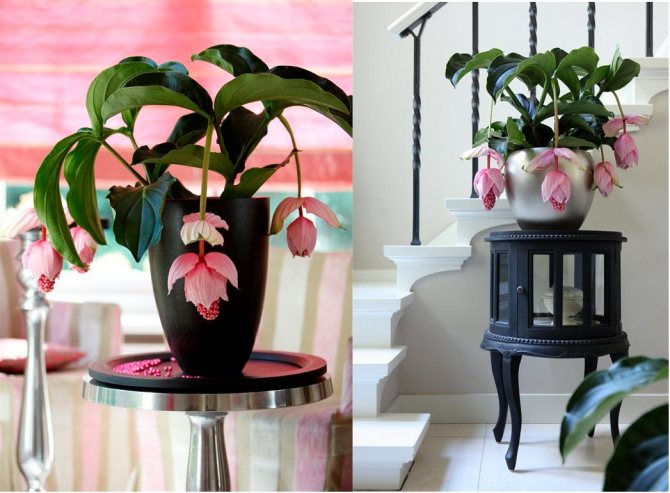

Medinilla can be grown as an ampel in pots on pedestals
Flower support
If your medinilla grows in the form of an ampelous plant in a hanging planter, its shoots and flower brushes hang freely, then it will not need support. If the medinilla bush grows on a stand in a pot, then over time, its stems, weighed down by a massive crown, begin to slope in different directions. This problem can be prevented at the very beginning by installing a cone-shaped support in the pot. Such a support can be purchased in stores or made yourself. For example, place bamboo sticks around the edge of the pot and connect them with flexible wire. The goal is not to allow the stems to deviate too much from the vertical.
Features of medinilla
Outwardly, medinilla looks like a small shrub, its height usually does not exceed two meters. The branches of the plant are erect, ribbed and bare, but sometimes they can be covered with small bristles. They are flexible at first, but harden with age. Leaves are rich green, smooth, large, with a glossy surface and pronounced venation (from 3 to 9 veins). There can be three types: opposite, sessile and short-petiolate. Their shape is elliptical or broad-lanceolate.
Medinilla flowers blooming in spring are very beautiful, for which they are appreciated by flower growers. They are collected in inflorescences hanging down in the form of heavy bunches. The flowers themselves are small, cupped, tubular or bell-shaped, have 4-5 petals. Their color is pink, white, pink-red. In some plant species, they are surrounded by large bracts that fall off at the beginning of the flowering period.
The fruits of the plant are fleshy, pear-shaped or oblong. Inside the pulp are smooth brown seeds. The root system is fibrous, highly branched.
Bloom
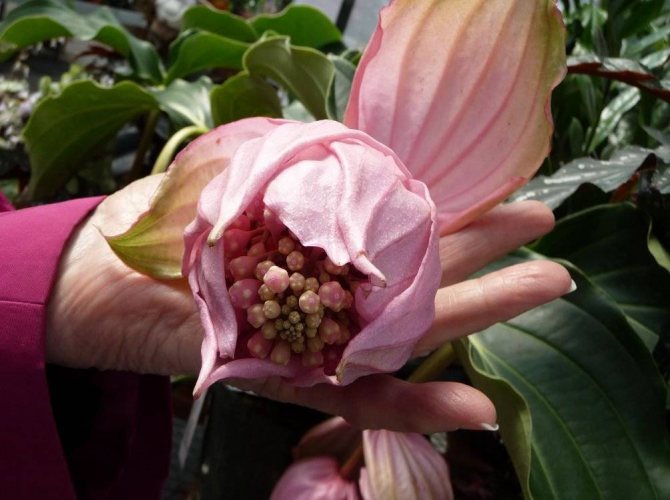

Medinilla usually blooms in late spring - early summer. Flower brushes open gradually and also gradually wither. Flowering can last and last up to two months, sometimes longer. The flowers have no smell.
Young bushes willingly grow flower stalks, but you should know that abundant flowering weakens young plants, so extra buds are removed on them. To make the buds open, do not move the pot to another place. Don't even turn it the other way towards the sunlight. Spray the flower with extreme care during flowering. Do not spray onto flower brushes. Water droplets can cause flowers and buds to darken and fall off.
It might be interesting: Tillandsia - home care
Peduncles with wilted flowers are best removed in order to stimulate the appearance of new inflorescences and not to spoil the appearance of the bush. Medinella sometimes sets fruits at home. If the peduncle remains, maybe you will see its fruits, which are no less decorative than the inflorescences.
Growing difficulties
When growing medinilla as an indoor flower, the following problems are possible:
- leaves shrink and curl - moisture is insufficient. To improve the situation, it is necessary to spray more often, and also place a wide container filled with water next to the plant;
- discarding leaves, buds, or buds - too frequent movement of the flower from place to place or insufficient moisture. In this case, you need to leave the flower alone and increase the humidity;
- the plant does not give flowers - improper care. Air humidity, lighting, temperature should be normalized;
- there are spots of brown or black colors on the stem - evidence of the presence of a fungal disease of Botrytis. For treatment, remove the damaged shoot and treat with an antifungal agent;
- scale insects Are the main pests that can appear in winter. You can get rid of them by rubbing the leaves with alcohol using a cotton swab;
- possibly damage by pests such as red ticks and scale insects, which can be successfully dealt with with soapy water or alcohol.
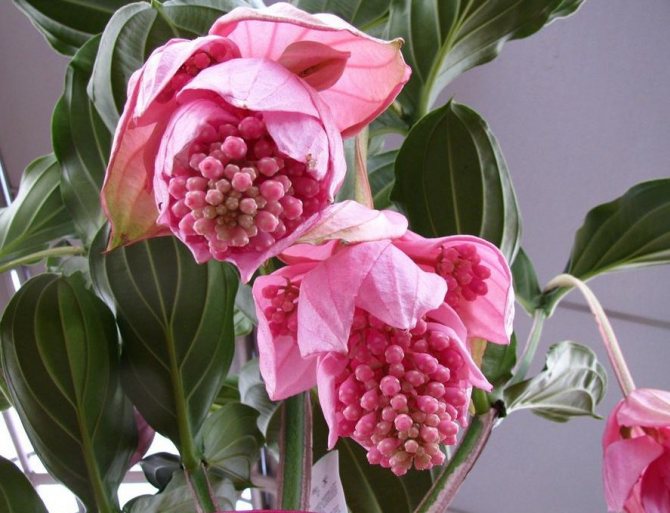

Medinilla is a wonderful tropical plant, which, if desired, can be grown at home, knowing how to do it and what difficulties may arise.
Pruning
This tropical plant responds positively to sanitary and formative pruning. So, pruning and crown formation can be carried out in early spring before the start of bud laying, for example, during the transplant of medinilla. The second haircut is carried out after the end of the flowering period.
- If your task is to grow a tall bush, remove only flower stalks.
- If you want to get a sprawling bush with a lush decorative crown, then halve the stems on which there were flowers, as well as especially long branches. Remove overgrown shoots or parts of them that spoil the decorative appearance of the bush. You can cut the shoots harder - right down to the woody part.
Any pruning rejuvenates medinilla, makes it branch better, gives the bush an attractive look. Cut shoots can be used as cuttings for propagation.
How to water?
Watering a flower directly depends on the season and, accordingly, flowering. The buds form at the end of winter, during this period medinilla is actively moisturized - often and in large quantities. The soil should always remain slightly dry. Since autumn, the watering of the flower decreases, and in winter, when the plant is in a state of calm, it can be watered even less often, only to prevent the leaves from drying out. Water is needed clean and warm, without adding lime.
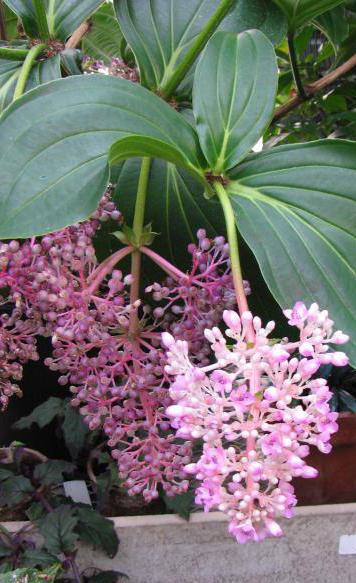

If the climate is damp or the water stagnates in the soil too much, the leaves of medinilla can become spots, the roots can rot. Therefore, you need to carefully monitor this.
Dormant period
The rest time for medinilla falls in the autumn-winter period. It is assumed that at this time she is resting and gaining strength for lush flowering next spring. And you must help her in this. Reduce watering. Reduce the temperature gradually to 17-18 degrees, but not lower. Stop feeding the plant. Maintain humidity by all means at a high level, and add lighting with phyto and fluorescent lamps for up to 12-14 hours a day. Your tropical beauty cannot bear the absence of light on long winter evenings.
If you continue to care for the flower, leave it warm, water it, and the lighting is high, then medinilla can bloom even in winter. We advise you not to let this happen.All the same, a tired medinilla will not be able to please you with a beautiful and long flowering, but you will not see flowering in the spring. So let medinilla rest in winter and gain strength for spring flowering.
Comfortable conditions for growing at home
The tropical flower in question is very capricious, therefore it is very important to create such conditions of detention that surround it in nature.
Lighting
For a comfortable life of a flower, a long daylight hours are needed: the light should be bright, but diffused. In winter, for this purpose, you can place a plant near a window that faces south. It is not scary if direct sunlight falls on the medinilla: in winter they are not scalding. Artificial lighting should be used if necessary. But in the summer, it is imperative to protect the flower from the bright midday sun.
Did you know? Rainforests cover only 2% of the earth's surface, but they are present on all continents except Antarctica, and are the natural habitat for 50% of the Earth's flora and fauna.
Airing
When ventilating the room where this tropical flower is located, you need to be careful: it does not like sudden changes in air temperature and drafts, so you should not keep it near a heater or wide open window.
Temperature
The optimum temperature in the room should be from +20 to + 25 ° C. In the cold period, a cold snap to + 16 ° C is permissible, but not lower. If the air is at a lower temperature, then this can provoke the death of the flower. Temperature readings above + 25 ° С are also not very comfortable for medinilla - in this case, an increase in air humidity is necessary.
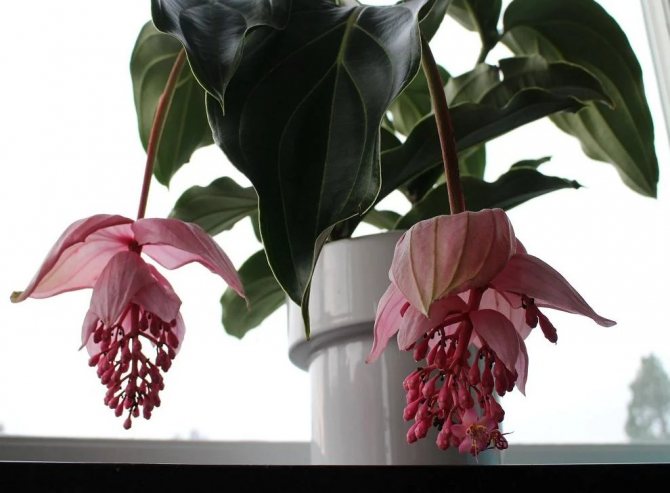

Air humidity
For complete comfort, the described plant requires a moisture content of more than 75%: in an ordinary house, such indicators are not easy to maintain. It is recommended to place containers with pebbles or expanded clay next to the medinilla, which are abundantly moistened. It is also necessary to constantly, several times during the day, spray with clean water, which has settled well. If possible, you can purchase air humidifiers. Such devices greatly facilitate the task of maintaining constant humidity at the desired level, especially during the heating season.
Important! Hard water will lead to a loss of decoration and diseases of medinilla.
How to choose medinilla in the store
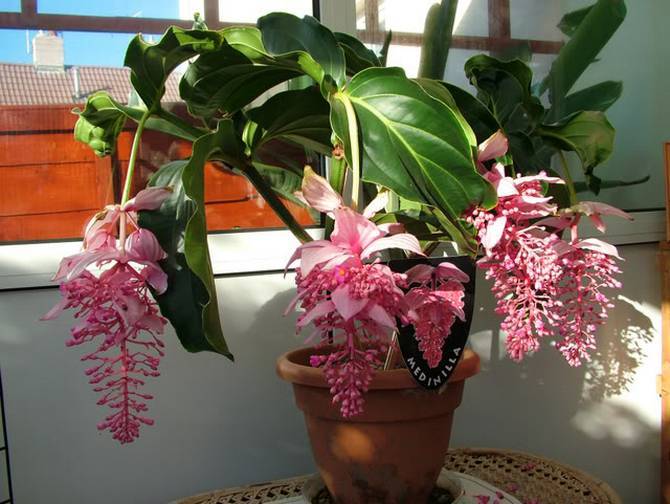

The best time to buy is summer and early fall. Approach the purchase very responsibly. Medinilla is an expensive flower, in case of an unsuccessful purchase, you will be sorry for the money spent in vain. Therefore, carefully inspect the stems and leaves of the plant you like, and also pay attention to the stem. It should be green without any spots. If you see spots, punctures, traces of pests, dry tips, weak shoots on the stem or leaves - refuse to buy. If you get a sick plant infected with fungus or insects, it will not be easy to cure it.
Think in advance where the container with your flower will stand or hang, and choose an instance that suits you in size.
If you did not find any flaws and you are satisfied with the size of the selected copy, feel free to buy it and go home.
Florists often complain that two to three weeks after buying their medinilla, they fell ill and died. Most likely, the flower did not survive a series of changes in conditions of detention. Perhaps he was recently brought to the store, he has not yet had time to adapt there. Then you bought him, brought him home and gave him a new place to live. The flower could not come to terms with this and died. We advise you to buy those specimens that have been in the store for quite a long time (about a month), have adapted to its conditions and have remained vigorous, healthy and attractive.
Transfer after purchase
Place the flower in a pre-selected location for 2-3 weeks to adapt. Then you need to transplant the flower from the shipping pot into the permanent pot you have prepared. It should be 4-5 cm larger.
- Wash off medinilla leaves with warm water that may have been used in the store before selling.
- Carefully remove the plant along with the earthy clod. If the root system has grown firmly with the previous pot and is not easily pulled out, we recommend cutting the plastic pot with a hot knife so as not to damage the earthen lump of the plant.
- Place the lump in a new pot and cover with fresh soil. Follow all the transplant rules described above.
If you bought an adult shrub that has a lot of leaves and flowers, then take care of supports, to which you carefully tie powerful stems so that they do not break off.
Purchase rules
The best time to buy medinilla is spring or summer. In autumn and winter, you should not acquire a plant, since a sharp temperature drop can cause a fungus in it. When selecting medinilla, it is necessary to check whether it is healthy, in what condition the leaves are, whether there are spots, yellowness, or damage on them. If there is, this is a sign that the plant does not have enough light or it is susceptible to attacks by pests, which means it hurts.
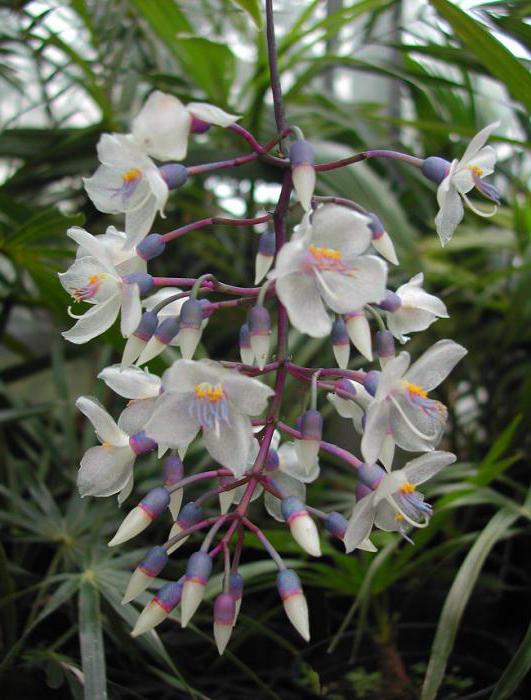

Medinilla must also be transported with caution. It is a very fragile plant, sensitive to almost everything. Therefore, the future owner of the flower needs to take care of a special packing sleeve in advance, which will hold it tightly.
Reproduction of medinilla
Unfortunately, medinilla is difficult to reproduce. It is usually difficult for novice growers to grow a new medinilka on their own. But worth a try. The main methods of reproduction of medinilla are seeds and cuttings.
Seeds
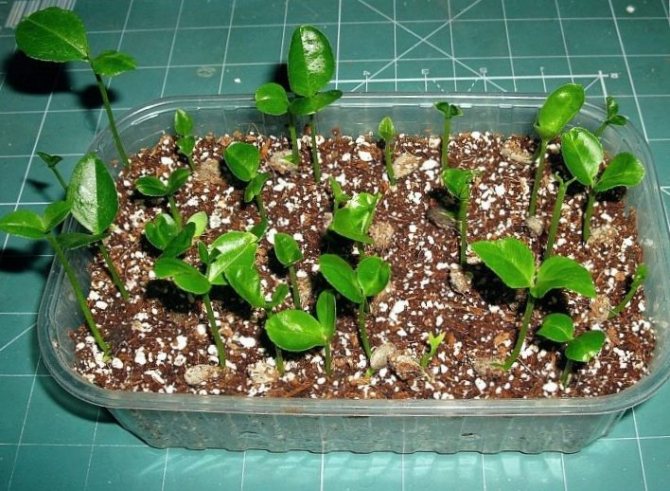

If you become the owner of fresh medinilla seeds, then try to grow a new bush from them at home. We recommend planting seeds in late winter or early spring. Fill a small container with sod (leaf) soil and sand. Spread the seeds on the soil surface, deepening them by 0.5 cm and at some distance from each other. Then you should abundantly moisten the planting with a fine spray bottle with warm water. Be sure to close the container with a lid - this will increase the percentage of seed germination. Place the greenhouse in a warm, well-lit area, but not in direct sunlight. When the seeds hatch (after 3-4 weeks), the container should be ventilated daily, the accumulated condensate should be removed and, if necessary, the substrate should be moistened. After the appearance of 2-3 new leaves, a pick can be carried out.
Cuttings
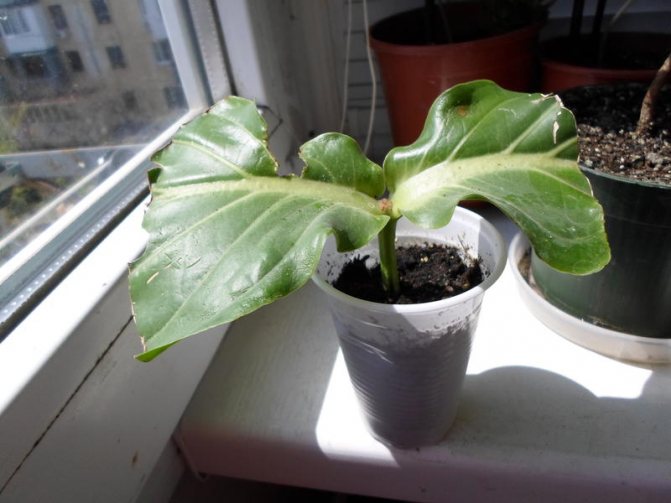

For propagation by cuttings, select small shoots on the mother bush, on which there are at least 2-3 nodes. In order not to spoil the appearance of your beauty, do it in early spring during pruning or transplanting the plant.
Place the prepared cuttings in a glass with warm, settled water or in a container with wet peat under the lid. The temperature should be high between 25 and 30 degrees. heat. Since medinilla does not take root well, we recommend adding the root growth stimulator Kornevin to the water. (Solutions with 3-5 drops of aloe juice and honey - 1 tsp per glass are also good for stimulating root growth and strengthening the immune system). Add the same to the water for watering the substrate in the greenhouse. After good roots appear (after about a month), transplant the sprouts into pots with suitable soil. Pinch the top to stimulate the growth of side shoots.
This might be interesting: Lantana - home care
Views
As an indoor culture, only Medinilla is grown magnificent. Under natural conditions, the shrub grows up to 3 m in height, in an apartment - no more than 1 m. The leaves are leathery, oval, up to 30 cm long. On the upper side, they are dark green with venation, and slightly lighter on the bottom.Flowering begins in April and ends in July. The flowers are pink, cupped, with 5 petals, collected in long cluster inflorescences (about 0.5 m).
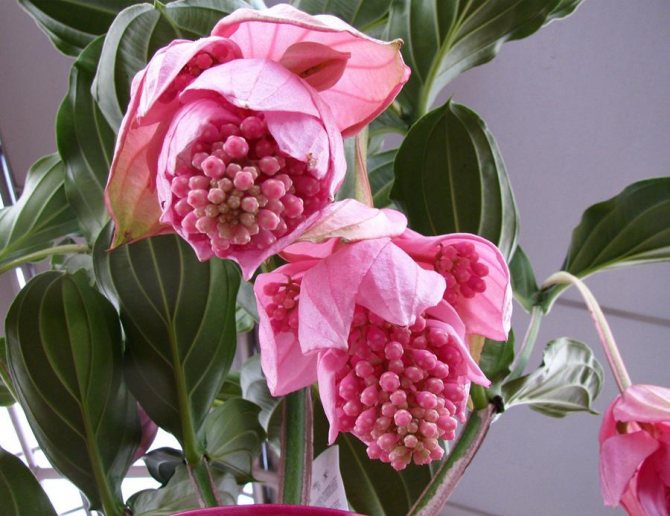

Medinilla is magnificent - a plant from the genus Medinilla of the Melastomaceae family
A characteristic feature of this species is large greenish-pink bracts. In the fall, blue-violet fruits ripen, similar to grape bunches.
In addition to gorgeous medinilla, growers also grow its hybrids.
- Zhadore Dolce Vita is a plant with deep pink flowers. Numerous narrow bracts are evenly distributed over the flower race.
- Medinilla venous is a shrub with thin shoots. Decorative dark green oval leaves with a pointed edge, 9–20 cm long. Leaf blade with embossed venation. Under the foliage are inflorescences with white tubular flowers.
- Medinilla sedum-leaved is a dwarf species with creeping shoots no more than 15 cm long. Leaves are dark green, leathery, with a faintly visible central vein. A rounded leaf blade with a diameter of slightly more than 0.5 cm. The flowers are bright pink, with white long filaments, bloom along the entire length of the shoot. Their diameter reaches 1.5 cm.
- Medinilla Javaniks are less capricious in nature. Short bushes with dark green ovoid leaves grow well in rooms with normal humidity. The drooping racemes are bright purple; bracts are absent.
- Medinilla Cuminga is a low, spreading shrub with shiny oval leaves up to 30 cm long. The surface of the sheet is slightly concave. Pink flowers are collected in racemose inflorescences.
Varieties in the photo
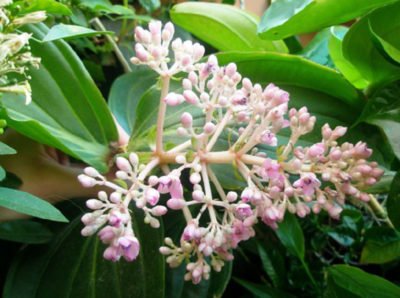

Medinilla javanica is famous for its less capricious character Medinilla sedum-leaved - a dwarf species with shoots no more than 15 cm
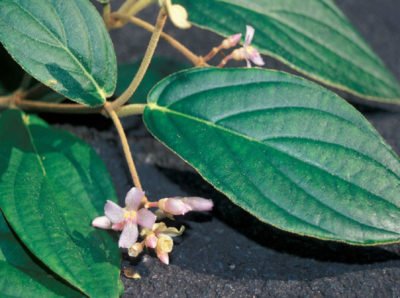

Medinilla veiny has beautiful dark green oval leaves. Flowers of medinilla Zhadore Dolce Vita are distinguished by a more intense pink color
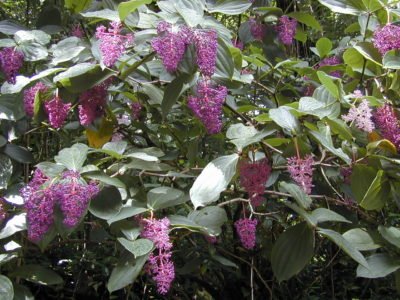

Medinilla Cuminga is a low, spreading shrub
Common care errors and how to fix them
Medinilla reacts strongly to florist errors. Even minor, from your point of view, deviations from the norm in terms of temperature and humidity can lead to some kind of health problem or the appearance of the flower. Let's try to deal with them together. In the table, we have indicated some mistakes in flower care:
| Care errors | Effects | How to fix |
| The indoor climate is dry. | - new leaves will become small; - leaf plates will dry out or curl; - the plant will not bloom. | Using all available methods to increase the humidity of the surrounding air: spraying, containers with water, pallets with wet moss or expanded clay, household air humidifiers, wet towels on batteries - everything is used when you need to help a green friend. |
| Lack of lighting, drafts, moving the pot to another place. | - the formation of a small number of buds or their complete absence - the fall of flowers and buds. | It is necessary to organize additional lighting, prevent drafts and not move the pot during the flowering of medinilla. |
| Excessive lighting, the flower is in direct sunlight. | - light spots will appear on the leaves. | Protect the bush with blinds or light curtains, or set it aside from the window a little to the back of the room. |
| It is cold in the room (batteries are not heated in autumn). | - the leaves will dry up; - the leaves and stem will turn black. | Reduce watering. The topsoil should dry out 2-3 cm between waterings. Raise the air temperature in the room to the required values using electric heaters. |
| Frequent and plentiful watering of the soil, stagnation of water in the sump is allowed. | - spots will appear on the leaves; - the root system will rot. | Watering rates need to be adjusted. But first, make sure nothing happened to the roots. Remove the flower from the pot and examine the roots.Rotten and damaged - cut with a clean, sharp tool. Treat wounds with crushed charcoal or ash. Transplant into a new substrate according to all the rules. Do not fill. If the soil seems dry and the watering time is not right, spray the foliage generously. |
| Medinilla is not provided with a rest period. | - the plant will not bloom profusely next season | Do not forget to organize the correct wintering for the flower. |
What happens when a flower is improperly looked after
Even the smallest changes in the environment or care are immediately reflected in the condition and appearance of the tropical capriciousness.
A less capricious plant is the peacock flower or episode. You can find out about the conditions of its cultivation from the material:
Care errors and what to do to eliminate them - table
| Errors | How to fix the situation |
| The plant does not bloom, new leaves are small. | The microclimate is too dry. Increase the humidity of the air, spray the bush as often as possible. |
| Falling buds and flowers. | The reasons are short daylight hours, drafts, movement of the flower. Use additional lighting, protect from drafts, do not move the pot. |
| Light spots on the leaves. | Occur as a result of excessive lighting. It is necessary to shade the bush from the bright sun. |
| In winter, foliage dries. | The reasons are a very cool room, waterlogging. Raise the temperature in the house, let the soil dry out. |
| Leaves dry up in summer. | The apartment is hot and dry. Maintain the air temperature no more than +25, spray the leaves. |
| Blackening of the stem and leaves. | The plant suffers from excess moisture, cold. Establish proper watering, moisten the soil only after the top layer of the earth has dried. Maintain optimal temperature values depending on the season. |
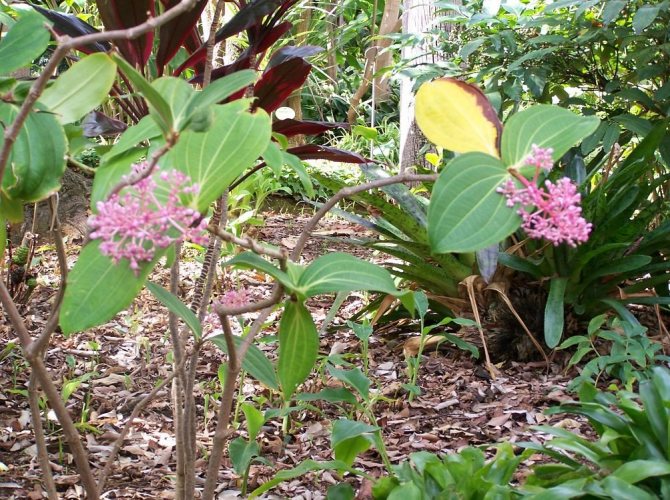

Bright rays of the sun cause leaf burn
Diseases and pests
Medinilla usually has strong immunity. But over-wetting the substrate can lead to rot, and dry air and substrate attracts mealybugs and other parasites. Sometimes medinilla becomes infected from other indoor plants and reacts painfully to violations of the watering or lighting regime.
Botrytis gray. Signs of this disease - dark spots appear on the stems and leaves. To prevent the disease, you should avoid excessive waterlogging of the soil, water it with warm soft water, feed the flower in time, and strengthen its immunity.
If your beauty is still sick, try this. Remove all diseased plant parts. Treat the sections with greenery or activated carbon. Let them dry. Then spray with Fundazol. Remove as much topsoil as possible from the pot and add fresh soil to the area.
Mealybug. You will guess about the appearance of this parasite by the presence of white bloom in the form of lumps on the leaf plates. The flower will begin to fade, because insects sucking its juice retard the growth of the plant, the leaves turn yellow and dry out. In order to cure the plant, wipe all leaf plates with a cotton swab dipped in soapy water. Then sprinkle with garlic infusion a couple of times at intervals of 7 days. Keep the room humid to keep the insect colony from growing.
If it was not possible to get rid of uninvited guests with folk remedies, you will have to resort to chemistry. Treat the plant with special chemicals - insecticides (Tanrek, Actellik and others according to the instructions for use).
Spider mite. You will recognize the presence of a spider mite by yellow dots (spots) and thin spider threads on the leaves and stems. First of all, take the flower to the bathroom and wash all the leaves with a warm soapy solution. Then wipe them with rubbing alcohol. In the absence of the desired result, you will have to buy insecticides (for example Fitoverm) and spray medinilla with them. This parasite reproduces in hot environments.In order to prevent, irrigate the leaves with warm water more often.
Aphid. The presence of aphids on the plant is evidenced by twisted leaves, a sticky coating on them, signs of flower wilting. Aphids are one of the most dangerous pests. It forms whole colonies on the underside of the leaves. If you find it, try to immediately wash off the insects in the bathroom under a warm shower. And then spray medinilla with aphid preparations, in which the main active ingredient is permethrin (Fitoverm).
Shield. The most noticeable pest that can be found during a visual inspection of the plant is the scale insect. It sucks out the sap of the plant, depletes its strength, leads to yellowing of leaves and shoots. You can get rid of this insect manually by removing the scabbards with a cotton swab or tweezers. Large colonies are safer to exterminate with the help of special chemicals (Aktellik and others).
Possible problems and ways to solve them
- The plant does not bloom, or there are very few flowers on it. There may be several reasons: incorrect temperature conditions, insufficient illumination, low air humidity. If these shortcomings are corrected, medinilla will begin to bloom;
- The flower began to shed buds and leaves. This most often happens if you often rearrange it from place to place. The plant needs a stable and constant light source. The reason may also be too low humidity levels;
- The leaves become small and begin to curl. Again, you need to provide the plant with normal air humidity;
- Dark brown spots appeared on the shoots. This is a clear sign that the plant is affected by a fungus and may die from this. It is urgent to remove the affected shoots, and then treat the flower with fungicides. Fungal diseases often develop due to excess moisture in low light. You need to constantly monitor the ratio of humidity and light;
- Medinilla is sold in the store. It is not recommended to buy discounted flowers, since, most likely, they are affected by some kind of disease, and it will not be possible to reanimate them.
Now read:
- Exquisite junkus (sitnik) spiral in the interior
- Choosing cucumbers for open ground according to your preferences
- Varieties, planting and care of perennial rudbeckia
- Decoration and spicy pepper dish on the windowsill
About
Agronomist of the state agricultural enterprise "Garovskoye" of the Khabarovsk region of the Khabarovsk region.
Description of the plant
Medinilla is a numerous genus of tropical plants, which include herbaceous vines, shrubs and trees. You can find them on all the islands of the Pacific Basin, as well as on the coasts of Africa, Australia and India. The medinilla flower has a fibrous, highly branched root system. Growth height ranges from 30 cm to 2 m.
Ribbed greenish-brown stems occasionally covered with bristles. Large leaves with a solid edge have a dense leaf blade. In the center there is a relief vein of a lighter color, from which 3-9 smaller veins depart. Bulky leaves are arranged opposite or whorls. They are colored dark green.
The most attention is attracted by medinilla inflorescences, which bloom in spring. They are located at the tops of the shoots and in the axils of the leaves. Long drooping or erect pedicels grow below the main part of the crown. Miniature tubular or bell-shaped corollas are collected in dense brushes. They are surrounded by larger bracts, which fall off soon after flowering begins. Delicate buds are colored pink, purple or salmon. The lush pith consists of elongated stamens with bright anthers and ovaries.
After pollination, pear-shaped or oblong berries with many seeds ripen. The small seeds are covered with a smooth brown skin and are wedge-shaped.
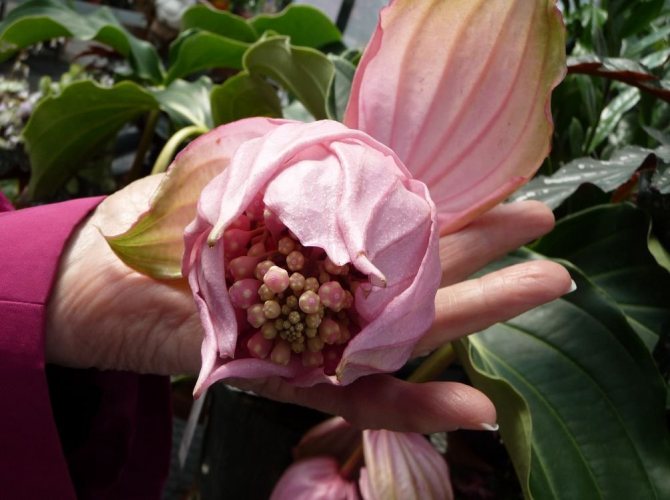

Possible problems, care errors
If you carry out improper care of medinilla at home, the possibility of some problems arising is not excluded. They are shown in the table.
| Problem | Reason what to do |
| Medinilla dropped all the leaves | The flower pot is often moved to another location. The situation can be corrected by transplanting the plant into another container or cutting cuttings from it for subsequent engraftment |
| Leaf blades curl or become small | Low room humidity |
| The flowering period does not come | Incorrectly organized lighting mode, low temperature or humidity in the room |
| The appearance of brown spots on the leaves | Plant damage by a fungus |
Pests
If you notice brown or even black spots on the stem, then this is a fungal disease of Botrytis gray. To combat it, remove the affected shoot and treat the plant with special agents based on a foundation against the fungus. For prevention, it is necessary to observe lighting, temperature conditions and air humidity.
The main problem is the mealybug. The first signs of the manifestation of this pest are white bloom, which resembles cotton balls. Also, the plant gradually weakens, begins to wither and eventually dies. It requires more powerful drugs of systemic action. Those that act superficially cannot cope with the worm.
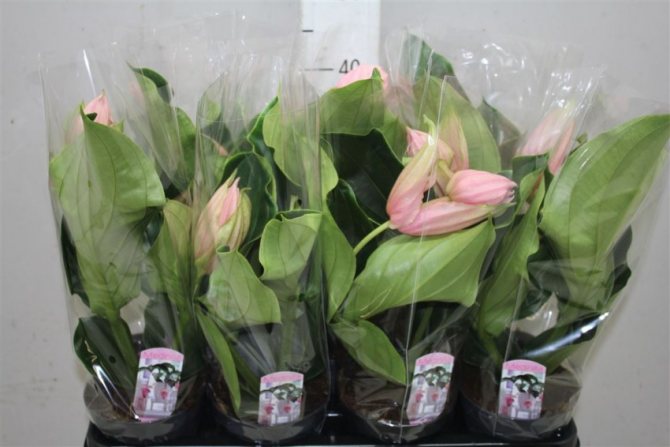

The appearance of a spider mite is accompanied by yellow dots and the formation of a thin cobweb. To get rid of it, you need to wipe the flower with a soft cloth moistened with alcohol or soapy water. If this does not help, it is worth treating with an insectoacaricide.
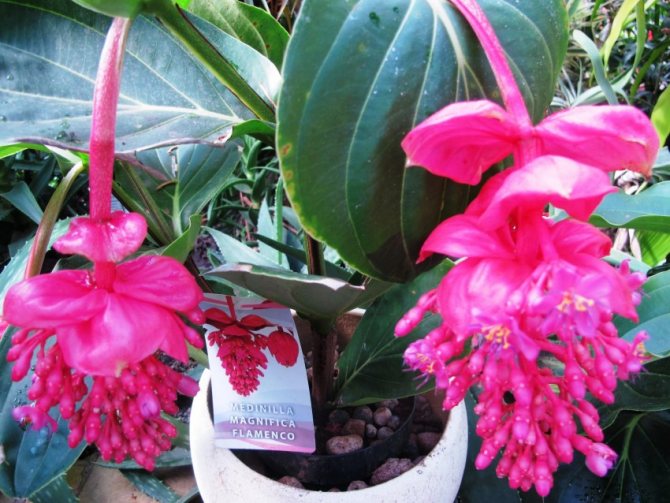

Main types
Catharanthus flower: home care and breeding methods
Florists grow a limited number of species. The most famous are the following.
Medinilla Magnifica
It is also called the magnificent medinilla. It is considered the most common type in home floriculture. Her homeland is the Philippine Islands. Breeders, taking as a basis medinilla Magnifica, received varieties such as:
- Dolce Vita - has massive clusters of pink inflorescences.
- Bello - is a miniature variety of medinilla. It has a short flower brush.
Gorgeous
- Jadore Tresor is a representative of a low-growing variety. It has white-purple or unusual bluish flowers.
Medinilla veiny
Veinous melastoma is the second name of medinilla. Her homeland is Malaysia. The plant has aerial roots that descend to the ground. Therefore, the vein medinilla is considered a semi-epiphyte.
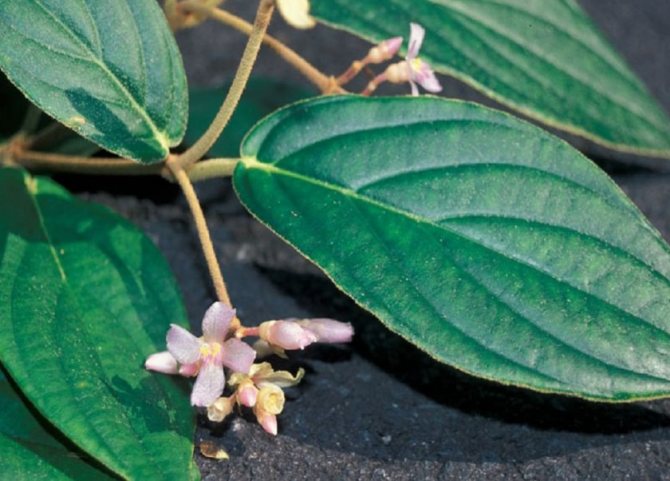

Veined
The leaves of this type of medinilla are small, with a bristly surface and a sharp end. The inflorescences are flesh-colored and have the appearance of an umbrella.
Medinilla Cuming
The homeland of this type of medinilla is the Philippines. This is a semi-epiphyte. The leaves are shiny, with a slight concavity.
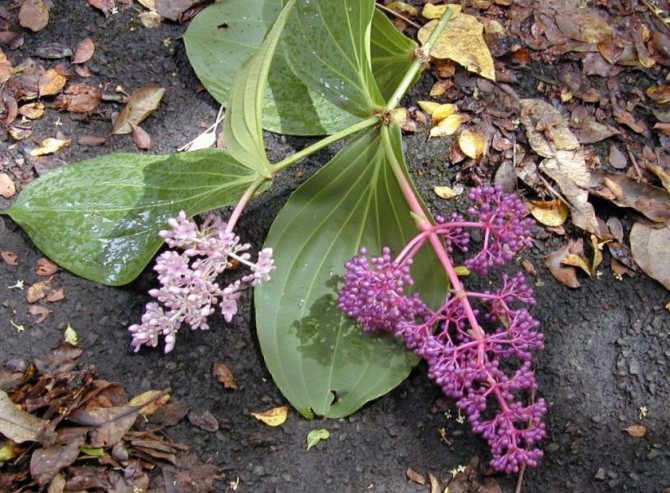

Cuming
Inflorescences of medinilla have the form of brushes with pink flowers, resembling lilacs.
Medinilla Javanese
One of the popular types of medinilla common in indoor floriculture is Javanese. The flower is unpretentious to care for, it looks like a small shrub up to 1 meter high. Javanese blooms with small lilac-purple flowers on the brushes. It does not differ in particular decorativeness due to the fact that it does not have bracts.
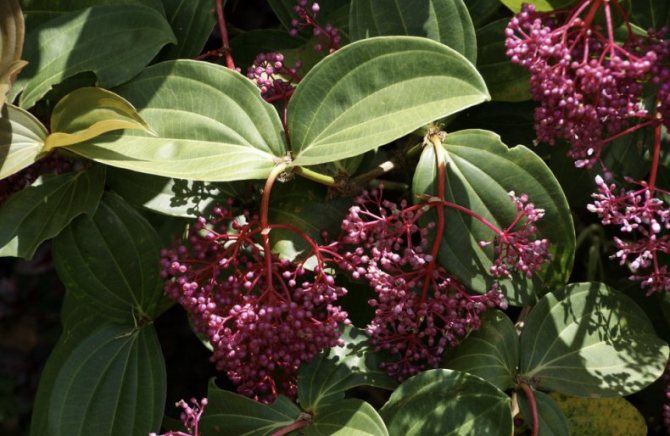

Medinila Javanese
When purchasing medinilla in a flower shop, you need to carefully examine it. If a dark spot is found on the stems, this indicates a sign of plant disease. Experienced growers who breed Medinilla varieties do not recommend buying discounted plants. If the plant is discounted, then something is wrong with its health. In this case, money will be spent, there will be no pleasure from the purchase.
Botanical description with photo
The genus Medinilla is assigned to the Melamastov family. It is home to the Pacific Islands, as well as the Asian and African tropics.It can be in the form of a liana, shrub or tree, has large leaves and inflorescences, but usually does not exceed 2 meters in height or length (for lianas). It has an epiphytic or semi-epiphytic (starting on a tree, ending on the ground) type of development, therefore it can grow both on the ground and on trees or other plants.
The leaves of a nobly muted gray-green color have a wavy edge and a rare light contrast venation. In some varieties, the leaf blade is serrated, but more often whole; petioles are also not available in all varieties.
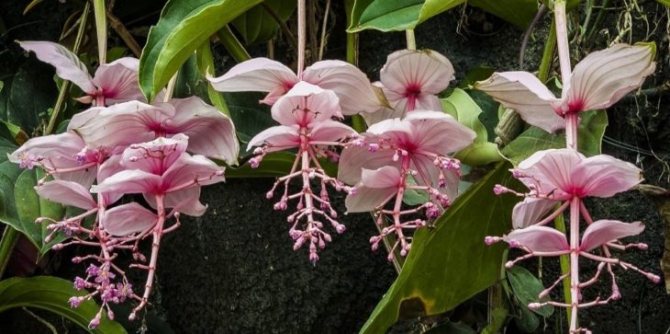

Useful properties of medinilla
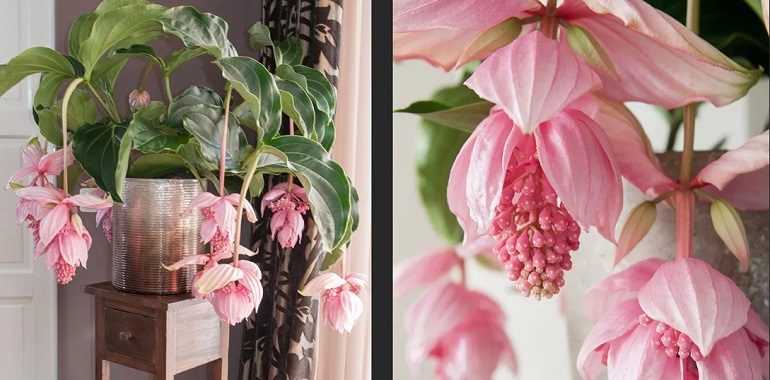

Medinilla magnifica
According to astrobiologists, contemplation of blooming medinilla calms, relieves stress and heals mental suffering. A large plant has powerful energy, helps to replenish the supply of mental strength. Taking care of an unusual flower that is difficult to grow at home, you can forget about your suffering. Medinilla harmonizes the environment in the surrounding space, balances the energy flows of family members.
Reproduction
The most common methods are from seed or cuttings.
The first option is quite difficult, especially for novice florists. But those who decide to take this step should remember that it is necessary to start planting seeds already in February, since there is a high risk of their non-germination.
A kind of greenhouse should be made from the pot so that the temperature is always comfortable for the flower. When sprouts appear, they must be dived into a separate container for the further formation of a full-fledged adult plant.
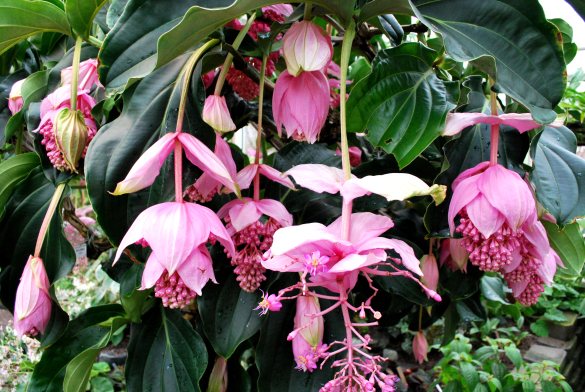

Medinilla buds close up
The whole spring period is suitable for the second method. Plant the cuttings in the prepared soil, cover with cling film or a glass jar. There, maintain a temperature of at least twenty-five degrees. After a month, the shoots with roots are transplanted into pots.
Seasonal care
Medinilla has a pronounced growing season and rest. From spring to autumn, it actively grows and blooms. She needs a lot of light, warm air, high humidity and regular feeding. From autumn to the end of winter, a dormant period begins. This is the bud-laying time. To ensure abundant future flowering, it is necessary to lower the air temperature to + 15..17 ° С. Lighting should remain plentiful. To extend daylight hours, you need to turn on additional illumination. Watering is reduced, but the soil must not be completely dried out... Top dressing is not necessary until spring.
Possible difficulties
The main difficulty in caring for medinilla is maintaining high humidity. With a lack of it, the leaves begin to shrink and curl from the ends. The flower prefers to be in one place all the time, if it is often rearranged, then it will shed part of the foliage.
In case of insufficient lighting, the formation of flower buds is worse, therefore, if medinilla has not bloomed for a long time, you need to pay attention to this factor. In winter, additional lighting is often used.
Medinilla has strong immunity, but in a damp climate and with stagnant water in the soil, it can suffer from leaf blight and root rot. The damaged areas are immediately cut off, and the rest of the plant is treated with a fungicide.
The most common pests are mealybugs and spider mites. When they appear, the plants are treated with insecticides, according to the scheme in the instructions.
Types and varieties
This tropical plant in natural nature has more than 350 varieties. Not all species have adapted in the European climatic zone. Domestic breeders identify several of the most popular types of medinilla.
Magnificent (magnifica, beautiful)
An evergreen shrub, the height of which in nature can exceed 150 cm. The homeland of this variety is the Philippine Islands and the territory of Indonesia.
The size of the dark green leaf plate exceeds 25 cm. Straight and fleshy branches grow from scaly internodes. The maximum length of one inflorescence can be 30 cm. The bracts around the small bells are pale pink in color. The plant prefers a climate similar to a tropical one.
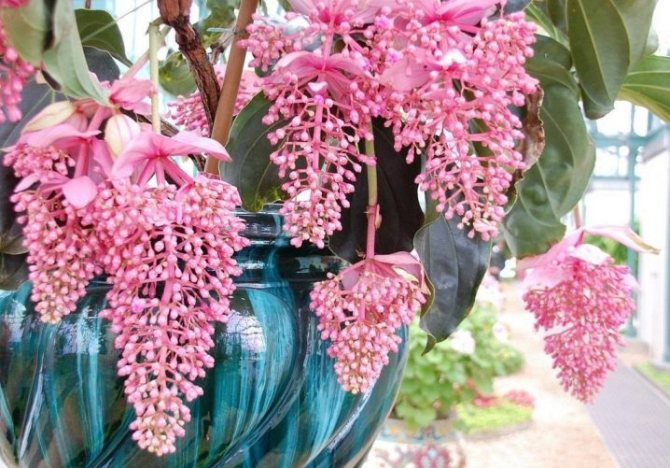

This species has several popular varieties.
- "Dolce Vita" - a plant with bright pink inflorescences, around which you can see several thin bracts.
- "Trizor" - an unusual variety that lacks bracts, and inflorescences with cone-shaped petals have a blue tint.
- "White" - a beautiful variety, has red inflorescences and short petioles.
- "Flamenco" - highly decorative variety, forms rich pink inflorescences. The maximum flower height in natural nature reaches 50 cm, and the size of one brush is 30 cm.
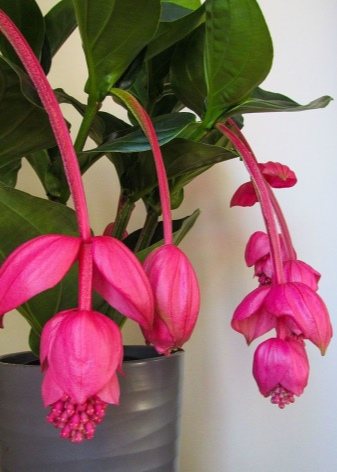

Veined
Partially epiphytic species, which has a thin shoot in the form of tubes covered with scales. The shape of the green leaves is oval with sharp edges, the maximum length is 25 cm. There are 7 veins on the upper side of the leaf plate. The color of the tubular flowers is white.
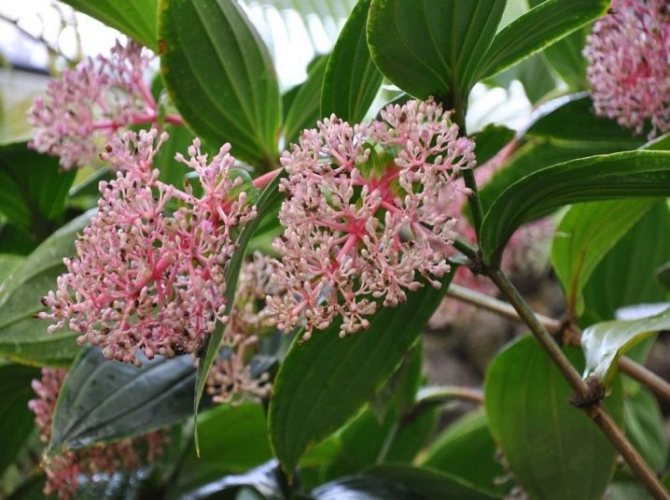

Cuming
Low appearance, characterized by ovoid leaves with a sunken surface. The length of the leaf plate is 30 cm.The size of the pink corolla is about 6 cm.
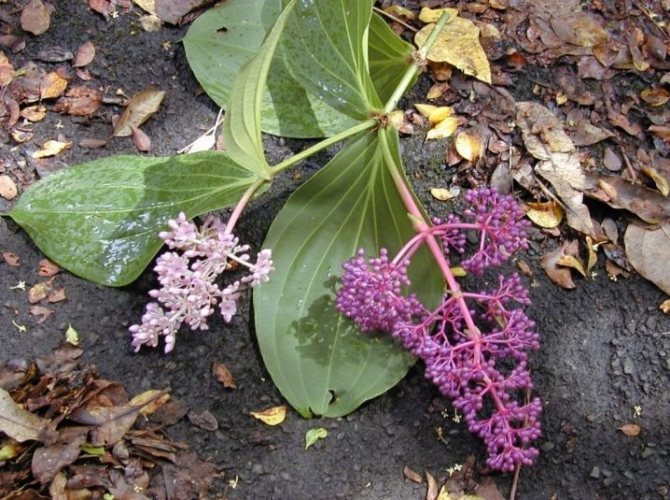

Javanika
An unpretentious view that feels comfortable in the European climatic zone. The leaf plate is green and oval in shape. A characteristic feature is the absence of bracts and the presence of deep purple flowers.
For home cultivation, biologists recommend paying attention to medinilla sedum. This species is intended for cultivation in terrariums and florariums. The plant is small in size, and the maximum length of the stems does not exceed 17 cm. The leaf blade is smooth and leathery. In each sinus, pink flowers are formed with a length of no more than 15 mm. A characteristic feature is the absence of bracts.
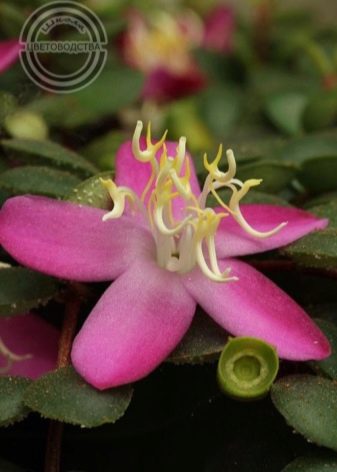

It is interesting
Medinilla is named after Governor J. de Medinilla. In Europe, the plant has been known since the 19th century. Under normal conditions, the flower grows up to 2 meters in length. In home gardens and greenhouses, the length is slightly shorter. There are about 300 plant species.
Medinilla leaves are large, glossy, smooth. The most remarkable thing is the medinilla flowers. They are of an unusual shape and bright color (red and pink shades). The flowers are shaped like panicles. They seem to be suspended from the stems of a plant. After flowering, unusual fruits are formed with a large number of seeds inside. The fruits are small, pear-shaped.
It is interesting! On all leaves of medinilla, a thick vein is visible, which runs exactly in the middle of the plant.
How to care for medinilla
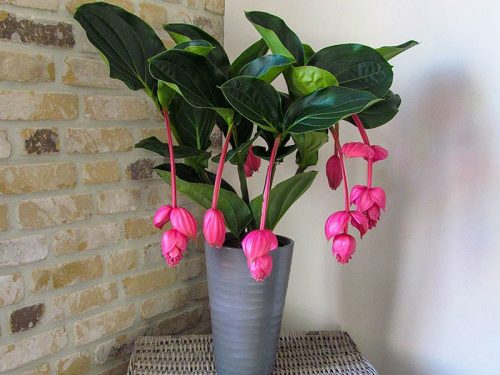

This flower is not one of those that a novice florist can handle. Although you can find information on the Internet that it is rather unpretentious, but this is perhaps a tribute to advertising. To successfully keep a beauty in an apartment, you will have to put in a lot of efforts and skills.
Location and lighting.
We have already touched upon the information that medinillas are large plants that look harmonious in spacious offices, large halls or studios. In an ordinary city apartment, it is difficult to find a worthy place for an adult plant. In addition, keep in mind that they do not tolerate a rearrangement, a change of "place of residence".
Bright, but diffused light during long daylight hours is what a flower needs. Our heroine does not tolerate blackout, but she also does not like direct, hard sunlight, as befits real princesses.
Comfort temperature
It will be optimal if you provide a temperature of 20 to 25 ° during the active growing season. As in the case of lighting, deviations in one direction or another are perceived by the plant as painful.
After the medinilla has faded, starting from about mid-September, the temperature should be gradually reduced, so that in winter it will be at the level of 15-17 °.At this time, a period of relative dormancy begins for the plant, when it rests.
Air humidity
In this component, the flower is very difficult to please! The ideal humidity for him is 80%, which, of course, is almost impossible to achieve in an apartment, unless you have a large glazed greenhouse. In any case, strive to withstand at least 70%. To do this, use all available means: from a humidifier to a wide pan with wet expanded clay. Spray the crown with soft warm water as often as possible.
Watering and feeding
It should be regular, plentiful, but neat. It is desirable that the topsoil has time to dry out a little between waterings. Use soft, warm, well-separated water. Neither soil drying out nor water stagnation in it should be allowed. Both that, and another, will quickly lead to the occurrence of various diseases.
Least of all, the flower needs to be watered during winter rest, most actively - at the very end of winter and early spring, when flower buds are forming and blooming.
Fertilizers are applied from March to the end of summer. It is advisable to do feeding twice a month using regular kits for flowering plants.
Soil features
The soil for medinilla needs to be prepared light, capable of being saturated with air and easily passing water. You can buy a ready-made soil mixture for epiphytic plants in the store, but if you make the substrate yourself, you should focus on the following composition:
- light sheet earth - 2 parts;
- sod land - the same amount;
- high-quality humus - 1 part;
- peat (preferably horse) - 1 part;
- coarse river sand - 1 part.
Planting and transplanting


Caring for medinilla at home involves regular plant transplantation. It is recommended to do this either in the fall, after the end of flowering, before leaving for winter holidays, or in early spring, even before the formation of flower buds. Considering that you are dealing with a very large plant, it is better to transplant every 2-4 years.
Always take the pot larger than the previous one, but not much. Make sure to provide a good drainage layer. The roots of the flower are tolerant of damage, so when transplanting, some of them can be removed along with the old soil.
The transplant should be combined with pruning. Remove dried inflorescences, cut out some of the old shoots. This will stimulate the emergence of new, young twigs.
Photo medinilla
Temperature
It is a thermophilic plant, as it grows in an area where mostly warm rainy forests. The temperature there does not drop below 15 degrees, even in winter.
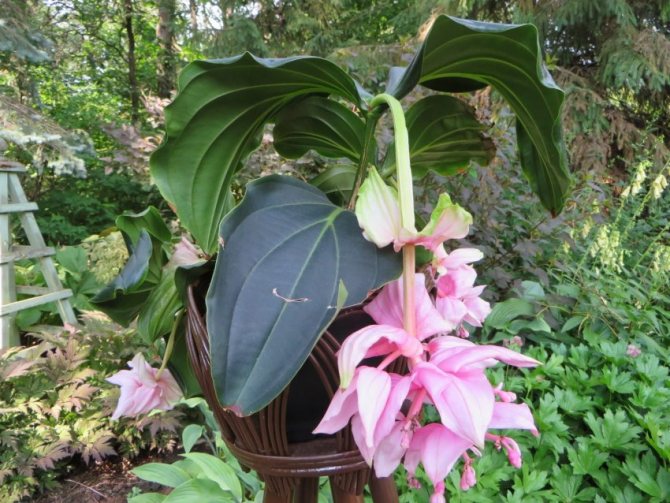

The optimal temperature regime for it will be 20-25 degrees in summer, and in winter - at least 16-18 degrees. It is also worth protecting the flower from drafts and heating appliances.
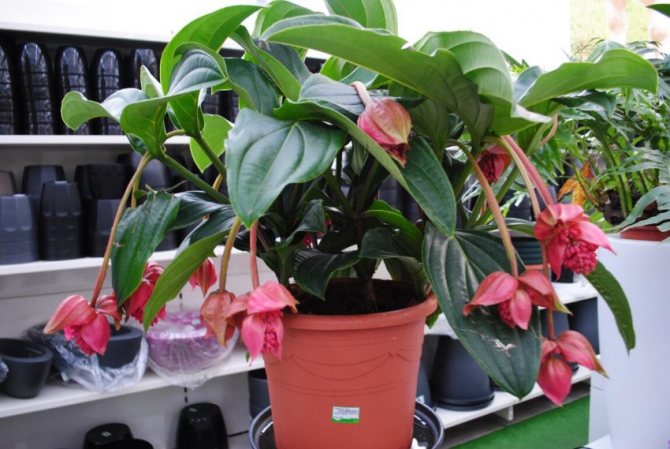

Possible problems
- Does not bloom or produces weak, deformed buds - insufficient light or humidity, low temperature.
- Threw off the buds and leaves - a frequent change of place, a draft.
- Young leaves are thin and small, and old ones curl - lack of moisture in the air.
- After spraying, the leaves and flowers were covered with brown spots - water droplets fell.
- The leaves have darkened - waterlogging of the soil.
Medinilla really requires a lot of attention and patience, but its magnificent bloom will more than pay for any efforts.
Plant selection and preventive measures. Photo of medinilla flower.
It is best to make a purchase immediately after the plant is delivered to the store. So gentle medinilla will be minimally affected by dry indoor air and will not have time to contract diseases from other plants. When choosing, carefully examine the undersides of the leaves. Most often, medinilla is affected by mealybugs. In this case, a white bloom, similar to cotton wool lumps, is found. Later, small sticky droplets may appear. Refrain from purchasing an infected specimen - getting rid of the worm is very difficult.
The roots of the plant should be kept in a special plastic container, which is removed during transplantation. For prophylactic purposes, immediately after purchase, the plant must be treated with a systemic remedy for mealybugs.
It is better to keep a resident of the tropics for several weeks away from other domestic plants, in quarantine.
Growing medinilla from seeds
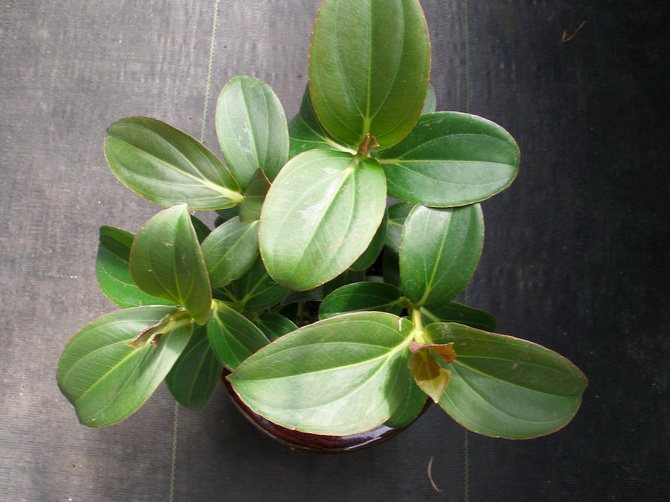

Medinilla from seed photos of seedlings
Medinilla can be propagated by seed and cuttings.
- Sow seeds in February-March.
- Sow in bowls with a mixture of turf and sand.
- Moisten the soil, scatter small seeds less frequently over the surface of the substrate and moisten from the spray gun.
- Germinate in greenhouse conditions: cover crops with glass or foil, keep the air temperature at least 25 ° C, regularly ventilate, moisten the soil.
- With the emergence of seedlings, you can remove the shelter.
- When 2 real leaves grow, dive medinilla in separate cups.
- The grown plants are transferred to a permanent pot and looked after as an adult plant.
Methods of reproduction of the medinilla flower
Medinilla can be propagated by seeds and cuttings.
Only semi-lignified stems with three buds are suitable for grafting. In early spring, cuttings are cut and planted in a mini-greenhouse with sand. Heating up to 25-28 degrees and regular treatment with phytohormones is required. Rooting should take place by the end of the month.
It is more difficult to get a new specimen from seeds. At the end of winter, they are sown in flat boxes with sand, providing constant warmth. Seedlings are transplanted into separate pots and kept in a greenhouse. In order for the young medinilla to grow stronger and form a bush, it is necessary to pinch the top. Flowers from a seedling should be expected only in the fifth year.
Medinilla: description
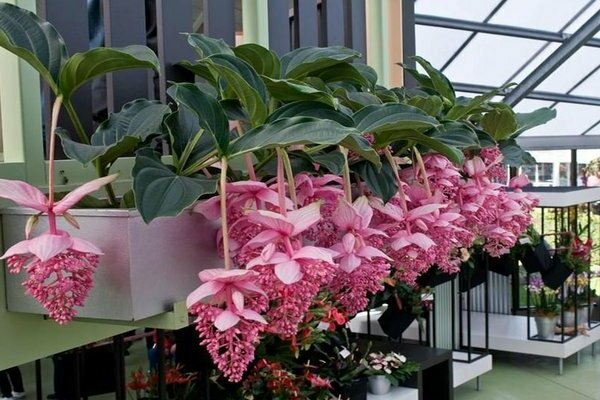

Medinilla flower: photo
The Medinilla flower belongs to the Melastomaceae family. In nature, these plants are represented by both herbaceous shrubs and small trees and vines, but as an indoor flower you can find only one species - "Medinilla magnifica" (magnificent medinilla). From the outset, your attention will be drawn to the bright pink striped bracts, which many mistake for flower petals, but in fact they hide many small flowers of an even richer pink color. If you saw medinilla only in the picture, then you may not imagine its true size. The length of the scaphoid bract is 10 cm, and the length of the rich green leaves of medinilla is about 30 cm.
The medinilla plant blooms magnificently in summer, and flowering largely depends on how well you cared for the plant from late autumn to spring, while it was dormant, because flower buds are laid in winter. After the plant has faded, seeds begin to ripen in place of flowers. If you plan to collect planting material, then it will be enough to leave one inflorescence for this, and cut off the rest. After the medinilla seeds are harvested, you should also cut off any old or starting to turn yellow and dry out the medinilla leaves, this stimulates the growth of young foliage.
1. Seven Secrets of Success:
| 1. Growing temperature: during spring and summer, grown at normal room temperature between 18 and 27 ° C. In winter, it is best to allow a cool dormant period at about 16 ° C. |
| 2. Lighting: shading from direct sunlight in the daytime, medinilla can be in the sun only in the evening and in the morning. |
| 3. Watering and humidity: watering with water at room temperature in such a way that the top layer of soil 2 - 3 cm thick dries up in spring and summer. In autumn and winter, the frequency of watering is reduced in accordance with the temperature of the content. Air humidity is high. |
| 4. Pruning: the tips of the branches are regularly pinched, the formative pruning is carried out after flowering, the wilting buds are removed. |
| 5. Priming: neutral or slightly acidic soil with excellent drainage and a loose texture, which allows moisture to pass through easily and allows the root system to breathe. |
| 6. Top dressing: Medinilla is fed with mineral fertilizers for flowering plants 2 times a month in spring and summer, in autumn and winter, feeding is stopped. |
| 7. Reproduction: stem cuttings, grown from seed. |
Botanical name: Medinilla.
Medinilla flower - family... Melastoma.
Origin... Philippines, grows in humid mountain climates.
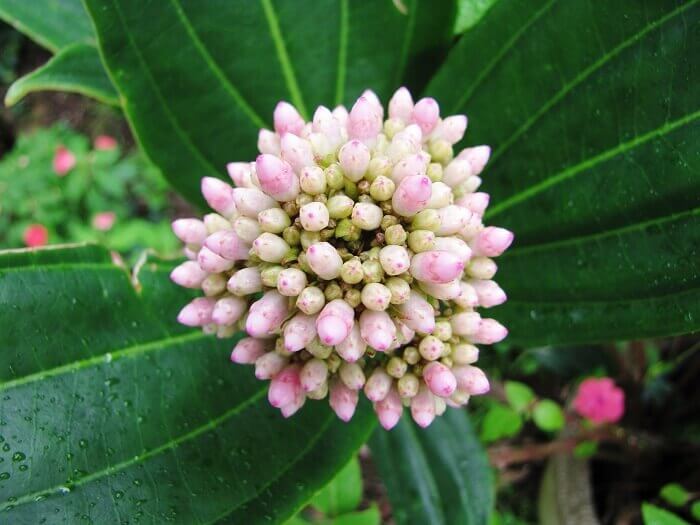

Description. Medinilla magnificent or magnifica is a fairly extensive genus, consisting of about 150 species of evergreen plants, which are shrubs with erect stems. The stems have edges and are quadrangular in cross-section. Leaves are simple, glossy, dark green, lanceolate, with pronounced veins and wavy edges, up to 30 cm long, arranged opposite, in pairs, sessile. Small pink flowers are collected in large branched inflorescences - panicles on long drooping peduncles. Each panicle is 45 cm long and has large pink bracts at the base.
Height... In nature, this plant can be a large shrub up to 2.5 m high, but in room culture it is pruned and it rarely exceeds 120 cm in height, it grows quickly.
Features of caring for gorgeous medinilla
When Dutch firms first brought potted medinillas to our city, despite their decent prices, they disappeared from sale instantly. I do not think that at least one plant survived from that first delivery from amateurs. Let's try to figure out why a tropical beauty does not take root in our apartments.
Temperature
There are several reasons. Firstly, medinilla lives in nature like an epiphyte in the mountain rain forests of the Philippine Islands, where it is constantly warm and humid, I emphasize - constantly. Heat does not mean hot, but the temperature does not drop below +16 ° C, even in winter. Therefore, do not buy the plant in frost, it may suffer ("cool down") during transportation, and you will not be able to save it. It is best to buy medinilla in the spring, when the apartments are warm and light.
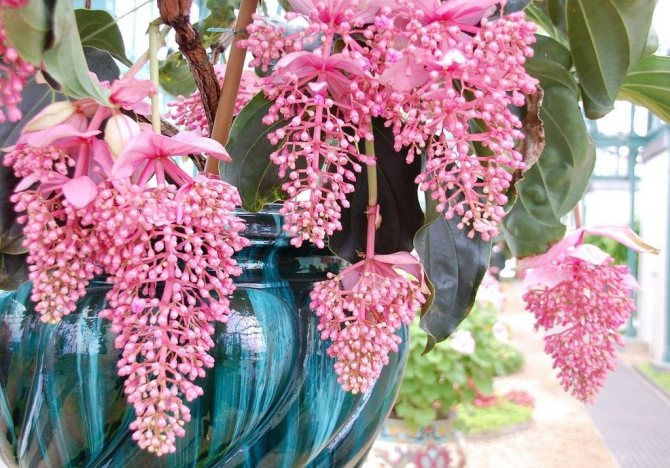

Medinilla magnifica. <>
Watering medinilla
The second reason for failures with medinilla, of course, is watering. If high humidity is required, this does not mean that the soil must be constantly wet. Medinilla needs a lot of water only during flowering in spring - in early summer, then from July to early autumn watering should be reduced. In a dark winter, the plant should rest, we water it only after the soil in the flowerpot is thoroughly dry. It is advisable to use soft, well-settled water with a temperature not lower than room temperature.
The choice of utensils for growing
Bought in the spring, brought home a large plant in a small plastic pot. I immediately want to transplant. Medinilla is large, sometimes up to 1.5 m in height, with heavy shoots, but, like most epiphytes, it has few roots and they are superficial. Pay attention to the choice of dishes. A shallow wide ceramic bowl is best suited, it can be planted in an epiphytic basket. We prepare the ground for landing light, breathable. You can buy a mixture for epiphytes, you can prepare it yourself: semi-rotten leaf earth, chopped sphagnum, fibrous peat. Good drainage is essential.
Medinilla transplant
During transplantation, medinilla can be cut off. Long branches are trimmed to give the shrub a beautiful shape. Thin winter shoots are removed. Cut semi-lignified shoots can be used for cuttings. For better rooting, a root formation stimulator should be used (for example, "Kornevin") and it is advisable to put the shards in a greenhouse with lower heating up to +22 - +25 ° С.
Top dressing
Transplanted, the plant received nutrition for a while, but a month after transplanting, you can start feeding.From March to mid-July, they feed every 10 days. You can take any fertilizer for flowering indoor plants, for example. "Kemira-Universal", "Darina". Do not get carried away with organic fertilizers, medinilla does not tolerate them well (especially mullein).
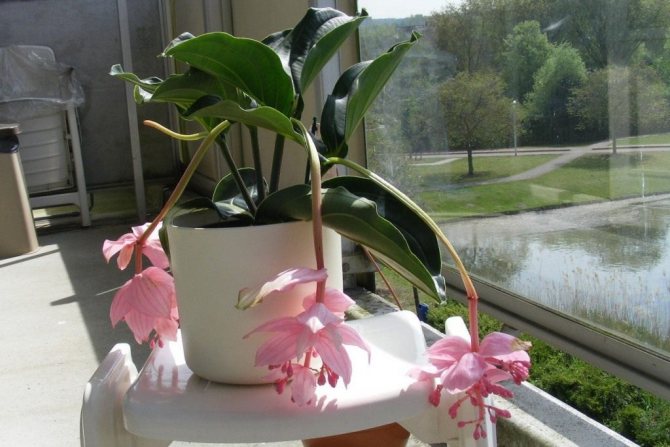

Medinilla magnifica. <>
Lighting for medinilla
The next ingredient for success is good lighting. In its homeland, medinilla is a shade-tolerant plant, but in our rooms there is clearly not enough light for it. In the summer, however, it is necessary, saving from direct sunlight and from burns, to move it into the back of the room. But with the onset of autumn, you should think about lighting. Without good lighting, medinilla will not bloom.
If, trying to provide maximum light, you put your beauty on a cold windowsill, the roots cool, and the plant will most likely die. Therefore, we set the backlight. The most reliable are special phytolamps from Osram or Phillips; unfortunately, there are no domestic household phytolamps yet.
Air humidity
Another important condition is air humidity. Medinilla loves very humid air, regular spraying is required, frequent washing of the leaves. The optimum air humidity is 80-90%. During flowering, try to avoid getting water when spraying on flowers, ugly dark spots are formed.
If you were able to fulfill all the conditions, then from May to August medinilla will delight you with bright inflorescences. Do not forget only that if flowering has begun, then you should not rearrange the plant from place to place and even turn it, the flowers may fall off.
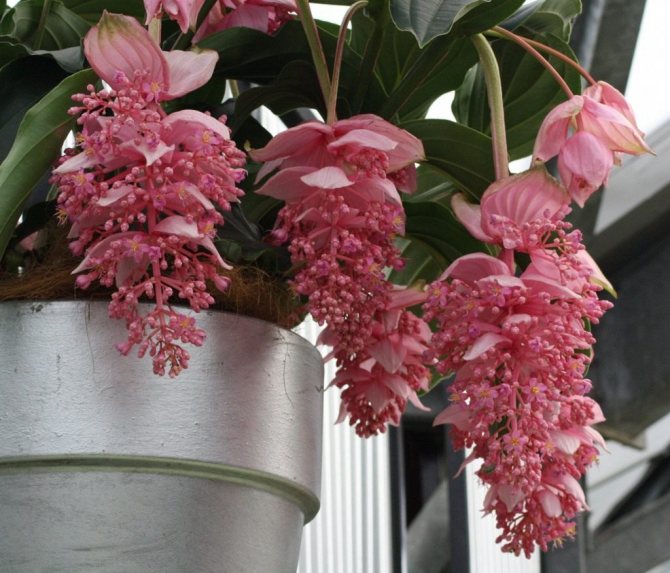

Medinilla is great.
Emerging problems
Caution! The fastidious Medinilla reacts painfully to any care mistakes.
You should know the symptoms of exposure to negative factors and how to eliminate them:
- Refusal to bloom - low light, low humidity or lack of conditions for a dormant period;
- Darkening of leaves - frequent watering and waterlogging;
- Shredding of young and rolling of adult leaves - insufficient air humidity;
- Loss of leaves and flowers - draft or rearrangement from place to place;
- Leaves dry in winter - low temperature; in summer - high temperature and dryness;
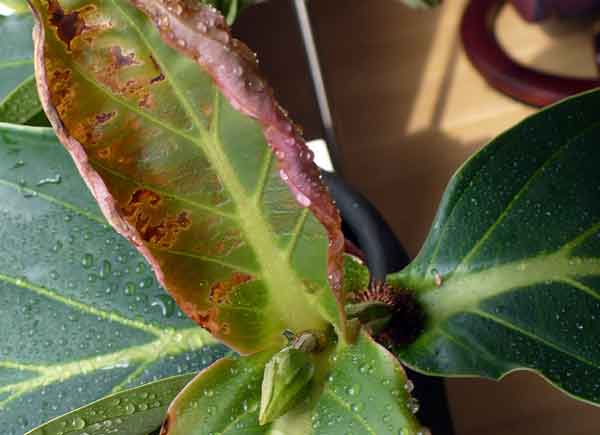

- Pale spots on the leaves - sunburn.
After finding out the cause of the trouble, it is necessary to correct the care regimes and further strictly follow them.
Lighting
The flower needs bright sunlight. If there is not enough light, then it may not bloom or shed existing buds. However, it is better to protect it from direct light, otherwise it will get burned.
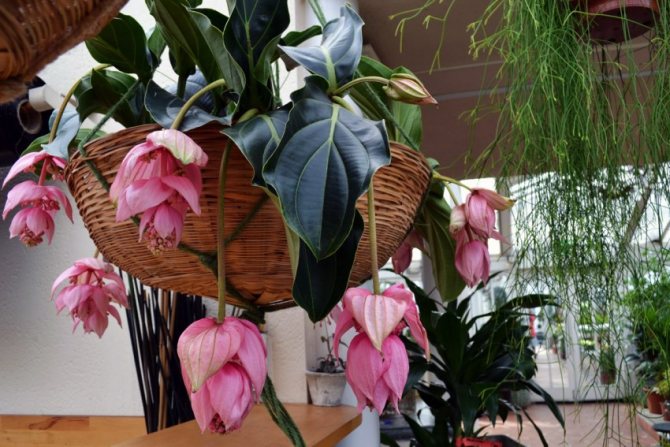

It is also recommended to use phytolamps for plants or fluorescent lamps if there is a lack of lighting.
